

Warp factor
- View history

A warp field dynamics monitor displayed the warp factors of the warp 5 engine and their relative faster-than-light speed equivalents

The USS Enterprise at warp 1 in 2259

In the alternate reality, the main viewscreen of USS Enterprise depicted the sublight and faster-than-light speed of the ship in warp factors at a three decimal place accuracy
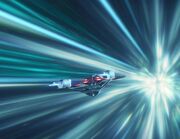
The USS Titan -A at Warp 9.99 in 2401.
Time-Warp factor , better known as warp factor , was the primary means of measuring speeds attained using warp drive . ( TOS : " The Cage ") The term was often shortened to warp when followed by its value, so that saying "warp six" was the same as saying "warp factor six." Light speed travel began at warp one, whereas lower fractional values sometimes measured sublight speeds or sublight factors . ( Star Trek: The Motion Picture ; Star Trek ; ENT : " First Flight " display graphic )
By the mid- 24th century , warp ten became infinite velocity and thus unattainable by conventional means. ( VOY : " Threshold ") Because of this, extremely high warp speeds mapped to decimal values between nine and ten, such as warp 9.975. ( TNG : " Encounter at Farpoint "; VOY : " Caretaker ") By the early 25th century , warp 9.99 became the max warp speed Starfleet vessels could achieve. ( PIC : " The Next Generation ")
Warp factor was one of the vocabulary words listed on the chart "A Tunnel in the Sky". This chart was seen in the schoolroom aboard Deep Space 9 in 2369 . ( DS9 : " In the Hands of the Prophets ")
- 1 Warp factor vs. average speed
- 2.1 23rd century
- 2.2 Infinite velocity
- 2.3 Alternate timelines
- 3.1 Related topics
- 3.2.1 Variations in relative speed
- 3.2.2 Star Trek: The Original Series
- 3.2.3 Star Trek: The Next Generation
- 3.2.4 Star Trek: Deep Space Nine
- 3.2.5 Star Trek: Voyager
- 3.2.6 Star Trek: Enterprise
- 3.2.7 Alternate reality
- 3.2.8 Apocrypha
- 3.3 External links
Warp factor vs. average speed [ ]
- ↑ Although Tom Paris clearly articulates the distance and time, it is unclear if he was engaging in hyperbole since these parameters indicate that, at warp factor 9.9 as specified, 75,000 light years can be traversed in less than 3.5 years.
- ↑ The Kelvans modified the USS Enterprise to travel at warp eleven through the galactic barrier . They did not clarify whether the same warp factor would have been used for intergalactic travel also.
Warp ten and above [ ]
23rd century [ ].
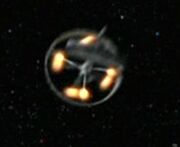
An Orion scout ship at warp 10
In the 23rd century , warp factors of 10 and higher were known as generally unsafe velocities. ( TOS : " Journey to Babel ") Speeds on the order of warp 15 were called multiwarp speeds. ( TOS : " The Changeling ")
- Warp factor 10 . In 2267 , the USS Enterprise engaged an Orion scout ship capable of warp 10, if not higher speeds, since crew safety was of no concern to them, prompting Spock to remark that it was " interesting. " The ship was too fast for the Enterprise to hit it with phasers or photon torpedoes . ( TOS : " Journey to Babel ") In 2268 , Bele , upon commandeering the engine and directional controls of the Enterprise , propelled the starship faster than warp 10 towards Cheron . ( TOS : " Let That Be Your Last Battlefield ")
- Warp factor 11 . In 2267, the Nomad probe improved efficiency in the antimatter input valve and energy release controls on the Enterprise , allowing the ship to achieve at least warp 11. When this happened, Montgomery Scott was in disbelief. Captain James T. Kirk ordered Nomad to reverse the modifications though, as the structure of the Enterprise was not designed to handle the stress of that much power output. ( TOS : " The Changeling ") In 2268, the Kelvans who commandeered the ship made similar modification. At that time the ship could maintain warp 11 without danger. ( TOS : " By Any Other Name ")
- Warp factor 14 . In 2268, the Enterprise achieved a speed of warp 14.1 when the engine of the ship was sabotaged to overload by a Kalandan planetary defense system . At that velocity the ship came within moments of destroying itself. ( TOS : " That Which Survives ")
- Warp factor 15 . In 2267, the Nomad probe was armed with a weapon system capable of firing energy bolts that traveled at the speed of warp 15. ( TOS : " The Changeling ")
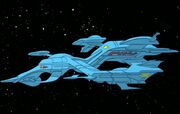
Karla Five's vessel capable of warp 36
- Warp factor 22 . In 2270 , the Enterprise was accelerated to speeds in the excess of warp 22, while being linked to Karla Five's vessel with a tractor beam . ( TAS : " The Counter-Clock Incident ")
- Warp factor 36 . In 2270, the Enterprise encountered Karla Five's vessel, that was about to enter the Beta Niobe nova. At maximum speed, the ship was traveling at approximately warp 36. ( TAS : " The Counter-Clock Incident ")
Infinite velocity [ ]
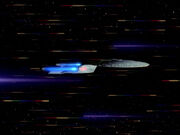
USS Enterprise -D accelerated to incredible warp speeds by the Traveler
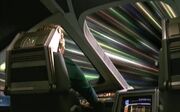
Shuttlecraft Cochrane accelerating to warp 10
In 24th century warp theory , warp factor 10 had been redesignated to correspond with infinite velocity. A vessel traveling at warp 10 occupied all points in the universe simultaneously. Warp 10 was also known as the transwarp threshold . ( VOY : " Threshold ") Warp 10 had also become a slang term referring to anything extremely fast. Kathryn Janeway made the observation in 2376 that rumors traveled fast on the USS Voyager . Chakotay agreed with Janeway, quipping at "warp 10." ( VOY : " The Voyager Conspiracy ")
- Warp factor 10- . In 2364 , the Traveler used the energy of his thoughts to move the USS Enterprise -D through space at a speed that registered on instruments as exceeding warp factor 10 and going off the warp scale. ( TNG : " Where No One Has Gone Before ")
- Warp factor 10 . Although considered a theoretical impossibility at the time, Tom Paris of the USS Voyager reached the warp 10 threshold in 2372 , using shuttlecraft Cochrane , which was equipped with a transwarp drive and an extraordinarily rare form of dilithium discovered earlier that year. After it was discovered that such travel induced hyper-evolution , this technology was discontinued after the initial test. ( VOY : " Threshold ")
- Warp factor 10+ . It was possible to travel backwards in time by surpassing warp 10. In 2365 , Captain Jean-Luc Picard and Commander William T. Riker speculated on what phenomenon could have thrown the El-Baz back through time. While Riker knew the shuttlepod didn't have warp drive , he still suggested the theory that it could have somehow accelerated beyond warp 10. Picard suggested this could have been achieved by a warp-powered slingshot using the gravitational pull of a star. ( TNG : " Time Squared ")
Alternate timelines [ ]
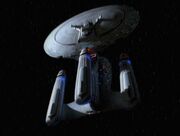
An alternative future Enterprise -D refitted for warp 13
In the original future , which was changed by Jean-Luc Picard, around the turning point of the 24th century , warp factor values beyond warp 10 were again used to describe extremely fast speeds. ( TNG : " All Good Things... ")
- Warp factor 13 . The Medical Spaceship Pasteur under Captain Beverly Crusher's command traveled at warp 13 in the incident concerning the anti-time eruption in the Devron system . ( TNG : " All Good Things... ")
Appendices [ ]
Related topics [ ].
- Bessel function
- Cochrane equation
- Cruising speed
- Emergency warp
- Maximum warp
- Slingshot effect
- Warp equation
- Time barrier
- Transwarp threshold
- Warp 2 barrier
- Warp theory
Background information [ ]
Variations in relative speed [ ].
Although formulas to calculate a relative speed from a warp factor have existed in the writer's guides, these were rarely used for reference in the episodes and films. To explain the apparent discontinuities of relative speed equivalents for warp factor speeds, reference sources have given several explanations:
- Star Trek: The Next Generation Technical Manual (p. 55) states the actual speed values of a warp factor are dependent upon interstellar conditions, for example gas density, electric and magnetic fields in different regions of the galaxy, and fluctuations of the subspace domain. Also quantum drag forces and motive power oscillation cause energy penalties to a ship using warp drive.
- Star Trek Maps (p. 6) introduced a similar concept as the Cochrane factor, that influences the actual speed by multiplying it. It can be as high as a multiplication of 1,500 to the relative speed within the curvature of space caused by the interstellar dust and gas of a galaxy, and as little as 1 in the empty intergalactic void. In the vicinity of massive objects it is so high that disproportionately high speeds are created when approaching them, and they tend to result in the slingshot effect . Between the galaxies there is only the empty void, so the speed follows only the basic cubic formula. ( see below ) Within the interstellar medium of Federation space the average value for the Cochrane factor has been calculated to be 1292.7238. This value explains, for example, the ball park of the fast relative speed equivalent for warp factor 8.4 from TOS : " That Which Survives ": 8.4 3 × 1,292.7238 = 766,202.57 times the speed of light.
The slowing down effect of moving away from a source of gravity to the relative speed has been well established in canon. For example in Star Trek , the Enterprise is at maximum warp but is not moving in space at all, due to the gravity of a black hole behind it. Similarly, in Star Trek IV: The Voyage Home , the HMS Bounty engages warp speed while in the atmosphere of Earth , and it takes over two minutes in the film for the ship to achieve and break out of Earth's orbit, but reaches the Sun's event horizon only a few minutes later. In TOS : " Elaan of Troyius ", a D7-class starship moving away from a star system at a speed better than warp 6 is moving slower than the speed of light. In some areas of space with unstable or disrupted subspace, it is impossible to use warp drive at all, as was established in such episodes as VOY : " Bride of Chaotica! " and " The Omega Directive ".
Many examples of more subtle variations exist. For example, in "By Any Other Name", the Kelvans modified the USS Enterprise to accelerate to a speed of warp 11 in order to safely cross the galactic barrier . If this was also meant to represent the velocity of travel to the Andromeda Galaxy , a travel time of three hundred years would indicate a far greater speed than can be derived from the basic cubic scale from the writer's guide. Warp 8.4 was stated to be much faster in "That Which Survives" than warp 9.9 in "The 37's". In TNG : " Allegiance ", warp 7 was stated to be about 55 times faster than warp factor 2, again confirming that fluctuations in the relative speeds exist that are not covered by the basic formula.
Star Trek: The Original Series [ ]
In his initial draft proposal, Star Trek is... (p. 9), Gene Roddenberry established the maximum velocity of the starship as ".73 of one light year per hour". This would translate to a top speed of 6394.8 c (approximately equivalent to TOS warp 18.56, or somewhere between warp 9.975 and 9.99 as given in the Star Trek: Voyager Technical Manual (p. 13)).
The original warp scale was described in the writer's guide, The Star Trek Guide , (third revision, p. 8) as a set of warp factors and multiples of light speed that can be obtained by raising a warp factor to the third power. [3] This information appeared in widespread print in The Making of Star Trek (1968, p. 191). The book also states a shift in relative time occurs while traveling at warp, an hour might equal to three hours experienced outside the ship. (p. 198) In 1975, the warp scale given a more technical gloss in Franz Joseph 's Star Fleet Technical Manual , now extended to include warp factors below 1. In 1977 Roddenberry again adopted the scale for the aborted Star Trek: Phase II series, but abandoned it for Star Trek: The Next Generation . It was not until the 2003 episode " First Flight " of Star Trek: Enterprise , that the warp factor scale made an official on screen debut. Warp factors from 1 to 5 were depicted with their corresponding relative speed values on a large computer graphic.
The scale used by Starfleet in the 22nd and 23rd century is based on a geometric progression, where the speed of a vessel (measured in multiples of c , the speed of light ) is equal to the cube of the given warp factor. The warp factor was calculated as follows:
![voyager warp 10 {\displaystyle wf={\sqrt[{3}]{\frac {v}{c}}}}](https://services.fandom.com/mathoid-facade/v1/media/math/render/svg/401aad0289011562cd093ac4d6ef5b053e795999)
- v being the speed of the signal or starship
- c being the speed of light (3.0 × 10 8 m/s) and
- wf being the resulting warp factor
Or, to calculate speed ( v ) in terms of c , the formula would be:

At warp 1, a starship would reach c ; at warp 6, it would reach 216 c . This is a much slower velocity than initially proposed by Roddenberry.
Using this scale:
Star Trek: The Next Generation [ ]
A document dated May 14, 1986 and attributed to Gene Roddenberry places warp 10 at the top of the scale: "Beyond that time-space continuity is disoperative." The corresponding velocity is given as "the speed of light multiplied by the speed of light ten times" , whereas warp 2 is now "the speed of light squared" , implying a general rule of the speed of light to the power of the warp factor. Aside from warp 1 mapping to the speed of light, it is unclear how this was to be applied in practice. There is, however, a clue in the statement that only 34% of the galaxy has been explored as opposed to 18% in TOS, suggesting improvements without major breakthroughs. [4]
The Writers'/Directors' Guide revision of March 23, 1987 confirms that warp 1 remains the speed of light and accepts warp 10 as " the physical limit of the universe – beyond that normal time-space relationships do not exist and a ship at that velocity may simply cease to exist . " As in the classic series, warp 6 is the highest cruising speed, though the stated equivalent of a light year per hour is more in keeping with .73 in the format of 1964 than the 41-hour light year by the cubed scale, or the 22 hours it would take to traverse the distance in the final revision. At this early version of warp 6, however, the Enterprise would need 308 years to travel the 2,700,000 light years it covered in TNG : " Where No One Has Gone Before ", consistent with Geordi La Forge's "over three hundred years" in the episode.
By the creation of Star Trek: The Next Generation Technical Manual , the warp factor scale used by Starfleet in the 24th century was based on a recalibration of the scale used in the Original Series . Rather than a simple geometric progression based on relative speed, warp factors were established to be based upon the amount of power required to transition from one warp plateau to another. For example, the power to initially get to warp factor 1 was much more than the power required to maintain it; likewise warp 2, 3, 4, and so on. Those transitional power points rather than observed speed were then assigned the integer warp factors. These transitional points were established to apply to the original warp scale as well in the canonical warp chart presented in "First Flight".
According to an article in Star Trek: The Magazine Volume 1, Issue 6 , p. 44 by André Bormanis , this scale change occurred in 2312 . A term was added to the above equation that caused the speed to rise slightly at lower warp factor, but to become infinite at warp 10. The ratio v / c at a given warp factor is equal to the corresponding cochrane value that describes the subspace distortion.
Gene Roddenberry stated that he wanted to avoid the ever-increasing warp factors used in the original series to force added tension to the story, and so imposed the limit of warp 10 as infinite speed.
For warp factors up to 9, the revised formula became:
![voyager warp 10 {\displaystyle wf={\sqrt[{\frac {10}{3}}]{\frac {v}{c}}}}](https://services.fandom.com/mathoid-facade/v1/media/math/render/svg/7db96ae9767de75ff2e7f21a75ad54520e2eda0f)
Or, to calculate speed in terms of c (up to warp 9), the formula would be:

In this case, warp 1 is equivalent to c (as it was in the 23rd century scale), but above warp 9 the speed increases exponentially, approaching infinity as the warp factor approaches 10.
Star Trek: Deep Space Nine [ ]
According to DS9 : " Emissary " and " Battle Lines ", the Bajoran Wormhole connected the Bajoran system to a region in the Gamma Quadrant 70,000 light years away. In "Battle Lines", Sisko stated that it would take Starfleet's fastest ship over sixty-seven years to cross the distance, suggesting the fastest ship in 2369 could travel at approximately 1,044 times the speed of light on a flight of that duration. The figure was further explained in the series bible, that it is more specifically a sixty-year journey at warp 9, [5] suggesting warp 9 would be about 1,167 times the speed of light.
In " The Sound of Her Voice ", the USS Defiant , traveling at warp 9, is three days away from a planet. Increasing speed to warp 9.5 took almost a full day away from the travel time. This indicates that warp 9.5 is almost 50% faster than warp 9.
Star Trek: Voyager [ ]
In Star Trek: Voyager Technical Manual (pp. 12 & 13) several other speed equivalents are established: Warp 9.6 is 1,909 times the speed of light. Warp 9.99 is 7,912 times the speed of light, which in turn is nearly three times the speed of warp 9.9. Subspace communication signals travel at warp 9.9999, a hundred times faster than warp 9.6, 199,516 times the speed of light.
In the pilot episode of the series, VOY : " Caretaker ", it is established that "at maximum speeds" it would take seventy-five years for Voyager to reach Earth, which was at that time approximated to be 75,000 light years away. This would mean that the maximum speeds of the Voyager were around approximately 933-1,000 times the speed of light. According to the Star Trek: Voyager Technical Manual , this calculation was meant to be based on an unrealistic non-stop direct journey at the speed of warp 9.6 (p. 14) or at warp 9.99 (p. 36). A realistic estimate, according to the manual, was that the journey would last somewhere between two and four hundred years when taking into account the required engine cooling time needed on such an extended journey.
According to Star Trek: Voyager Technical Manual (pp. 4 & 27), a sector (about twenty light years) took four days to cross at warp 9.6, five days at warp 9 and about nineteen days at warp 6. However, in VOY : " The Voyager Conspiracy ", the ship cuts three years off its journey by crossing thirty sectors, implying that they expected to travel more than a month (or approximately 36.5 days) to cross a sector.
In the episode VOY : " Flashback ", Captain Kathryn Janeway stated that the current Starfleet starships in 2373 were twice as fast to what the USS Enterprise -A and the USS Excelsior were in the 2290s . According to Star Trek: Voyager Technical Manual , (p. 13) the maximum rated speed of the ship was warp 9.975 or 3,053 times the speed of light. According to the Star Trek Spaceflight Chronology (p. 180) and Mr. Scott's Guide to the Enterprise (p. 14), the maximum speed of ships like the Enterprise -A was warp 12 in the old scale, or 1,728 times the speed of light.
Star Trek: Enterprise [ ]
Officially and according to the large warp chart featured in " First Flight ", the warp drive of Enterprise NX-01 used the TOS scale. Speeds in ENT : " Broken Bow ", which were mentioned as traveling at 30,000,000 kilometers per second and going to "Neptune and back in six minutes", fit well into the ballpark of cubic warp factors between 4 and 5. In ENT : " Regeneration ", Trip Tucker states that warp 4.8 (approximately 111 times the speed of light in the TOS scale) is double the speed of warp 3.9 (approximately 59), which is also a close enough margin of error considering it is an offhand comment made without navigational implications.
In the episode ENT : " The Expanse ", a location was given to Jonathan Archer as to where to look for the Xindi inside the Delphic Expanse. The location was stated to be a three-month trip away from Earth at warp 5. In the next episode, ENT : " The Xindi ", when Enterprise had arrived to look for the Xindi in that region, it was said they were fifty light years away from Earth. This indicates warp 5 would equal to a speed of approximately two hundred times the speed of light. This would fall closer to the TNG scale figure for warp 5 instead of the TOS scale figure of 125 times the speed of light estimated in the canonical chart.
There are, however, instances in "Broken Bow" that do not appear to be compatible with any of the basic scales. Zefram Cochrane notes in his recorded speech that the warp five engine would allow a ship to travel a hundred times faster than what they could in 2119 . Warp 2 was later on established to be the maximum warp ships in the early 22nd century had achieved in ENT : " Horizon " and " First Flight ". Warp 5, however, was only sixteen or twenty-one times faster than warp 2 in the scales. The journey from Earth to Qo'noS in four days was another instance. In either scale, Enterprise wouldn't even reach the closest star to Earth in four days.
In ENT : " Fortunate Son ", it is stated that a warp three engine would allow a ship to travel ten times faster than warp factor 1.8. This doesn't work out in either of the basic formulas, unless we interpret the statement to indicate that a warp three engine would allow a speed of warp factor 3.9 in the TOS scale or 3.6 in the TNG scale. Warp factor 3 would be only around five times faster in either scale.
Alternate reality [ ]

The alternate USS Enterprise at warp in Star Trek
In the alternate reality seen in Star Trek , the USS Enterprise traveled from Earth to Vulcan at maximum warp. According to ENT : " Daedalus ", Vulcan is located slightly over sixteen light years away from Earth. According to background sources maximum warp of the ship was Warp factor 8. [6] Directly after the ship had accelerated to and attained maximum warp, Captain Christopher Pike ordered Pavel Chekov to give an announcement of the mission to the crew. At the end of the broadcast, Chekov stated that the ship would arrive within three minutes.
However, there was an unknown amount of time the ship spent accelerating to maximum velocity, so there is no accurate way to ascertain the total travel time of the Enterprise from Earth to Vulcan beyond the obvious implication that it was not an especially lengthy trip. By comparison to the prime reality, in Star Trek IV: The Voyage Home , when the crew was returning to Earth from Vulcan on board the HMS Bounty , Sulu reported they would arrive in 1.6 hours.
In Star Trek Into Darkness , the Enterprise and the three-times-faster USS Vengeance were capable of traveling from the Sol system through the Neutral Zone to the edge of Klingon space and back in less than a day. Co-writer Roberto Orci acknowledged Montgomery Scott 's line about his time away from the Enterprise should have been something like "one week" rather than "one day". [7] As a comparison, in Star Trek VI: The Undiscovered Country , the internal clock of the USS Enterprise -A read 08:27 as the ship left Spacedock One and 16:12 when it arrived to the edge of Klingon space to meet up with Kronos One , for a trip of a little under eight hours.
Apocrypha [ ]
In the 25th-century timeline of the video game Star Trek Online , the warp speed scale appears to have been re-calibrated yet again to allow for the spread of new technologies such as a transwarp conduit network and quantum slipstream drive systems. Warp factors higher than 10 appear in the game, but only when a ship is using a quantum slipstream drive or exotic equipment such as Borg-enhanced "Assimilated Subtranswarp Engines". Speeds higher than warp 10 are classified as "transwarp factors", with higher numbers equating to faster speed. Borg subtranswarp engines allow ships to travel at an average speed of "warp 15", while activating quantum slipstream gives a temporary speed boost of up to warp 35.
The relation between warp factor and speed is s(F) = (F/20) light-years per second, F being the warp factor.
External links [ ]
- Warp factor at Memory Beta , the wiki for licensed Star Trek works
- Warp 10 at Memory Beta , the wiki for licensed Star Trek works
- Warp Speed Anomalies at DITL
Star Trek: Voyager's Weirdest Episode Answered What Happens If You Hit Warp 10
Star Trek: Voyager's "Threshold" stands as one of the weirdest entries in the whole franchise, but it found a strange way to answer a big question.
Star Trek: Voyager had a habit of swinging for the fences with its more high-concept episodes. When they succeeded, they created some of the series’ high points and helped put its own unique stamp in the Star Trek franchise. These included episodes like Season 2, Episode 24, “Tuvix,” which posed serious ethical questions in unique and fascinating ways. However, not every episode could hit the delicate balance required for that, and when they failed, the Voyager got weird, such as when answering what happens when hitting warp 10.
Season 2, Episode 15, “Threshold,” explores that question. Presented as a mystery, it builds to a reveal involving giant salamanders and easy sex jokes. It’s particularly odd considering it surrounds one of the staples of Star Trek ’s lexicon: warp speed . The moment could have defined one of Star Trek ’s key pieces of technology. Instead, it’s become a shining example of the franchise at its goofiest.
RELATED: Star Trek: Every Time Spock Commanded the Enterprise
According to the franchise’s rules, warp factors exponentially increase speed. For instance, a ship traveling at warp 6 moves more than twice as fast as it would at warp 5, which is more than twice as fast as warp 4 and so on. The barrier to that is warp 10, a point where, as Harry Kim explains, an object touches all points in the universe simultaneously. After the ship discovers refined dilithium on a new planet, Tom Paris thinks he can use it to hit warp 10 and bring Voyager home to Earth in an instant.
The episode makes an obvious nod to Chuck Yeager breaking the sound barrier. Tom’s increasingly fixated efforts to cross the barrier reflect a disregard for the potential safety problems. “Threshold's” early scenes play that tension well, as Tom, Harry and B’Elanna first test their theories in the holodeck before Tom ventures out in a shuttle to break the barrier himself. The science is shaky, even for Star Trek, but the suspense admirably builds, and the dialogue plants just enough hints about some kind of Frankensteinian consequences should Paris succeed. That helps the episode skirt around its omnipresent Gilligan’s Island question: the audience knows that Tom will fail since Voyager can’t return home just yet. The tension comes in what his flight will do to him.
RELATED: Star Trek: Every Time William Riker Commanded the Enterprise
Positing the question isn’t the episode’s problem. That comes with the answer, which “Threshold” at first seeks to defer in favor of more suspense. Tom’s flight succeeds, but it has untold effects on him, resulting in a slow transformation into a seemingly amphibious humanoid with a good deal of body horror included to keep the tension high. The word “quantum” floats around the entire episode, another term Star Trek often uses as a catch-all explanation for whatever concept it wants to explore, but the change still comes out of left field. It lacks any causal connections to Paris’s flight and turns its intriguing mystery into an utterly ridiculous one.
But it gets worse. As the physiological changes take hold, Paris abducts Captain Janeway and returns to the shuttle to repeat his warp 10 feat. The crew finds them three days later on an uninhabited jungle planet, transformed into six-foot-long salamanders. Moreover, they have bred, and their spawns are found nearby. Chakotay stuns them and returns them to the ship -- leaving their offspring behind -- while the Doctor restores them to their human forms. They simply remark how little of the experience they remember, and the ship flies on to the next Voyager episode.
RELATED: Fallout's Weirdest Event References One of Star Trek's Most Iconic Episodes
The disposable nature of the entire affair is the last touch for a concept that had gone wildly astray long before. The salamanders' nature and their connection to Paris’ flight are never mentioned, nor is the fact that they simply abandoned their genetic offspring to the wild without a second thought. Considering the way “Threshold” builds up the monumental achievement of breaking warp 10 -- Paris is compared to Zefram Cochrane and the Wright Brothers -- the nonchalance with which it tosses aside Tom’s success and his subsequent transformation are stunning. That extends to the elephant in the room: the fact that Paris and Janeway mated and conceived of children as giant salamanders, which the crew accepts without a second thought.
Terms like “best” and “worst” don’t really apply to episodes like “Threshold.” From an objective standpoint, it’s terrible. However, its terrible qualities come in such a freakish and unanticipated way that they become selling points in and of themselves. It’s ridiculous but lovable in its own way, no different than any of the other occasions that the franchise’s sillier side came out. Although, that doesn’t save it from its sheer head-scratching quality, leaving it the “ Spock’s Brain ” of Voyager and a contender for one of Star Trek ’s all-time weirdest episodes.
KEEP READING: Paramount Is Developing a Starfleet Academy Star Trek Series
Why Star Trek: Voyager's Threshold Episode Ignited An Army Of Outraged Fans
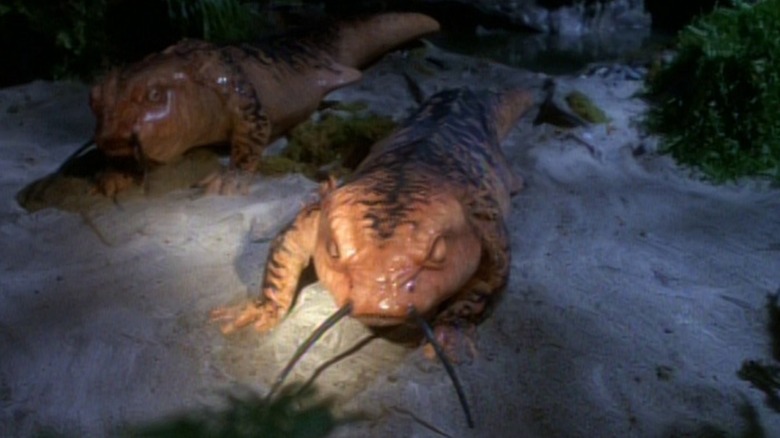
In the "Star Trek: Voyager" episode "Threshold" (January 9, 1996), the U.S.S. Voyager discovers a rare, extra-powerful version of dilithium, the crystal that is required to run starship engines. Using this new dilithium, the Voyager crew figure they can build an engine capable of passing the mythic warp-10 barrier, essentially allowing them to reach infinite velocity, passing through every point in the universe simultaneously. Such a breakthrough would allow the Voyager to return to Earth in a moment.
When testing their new engine, however, something goes awry. Tom Paris (Robert Duncan McNeill) returns from a test flight ... altered. He begins to mutate and change, losing skin and spitting out his tongue. It seems that the infinite velocity flight somehow triggered his body's evolutionary genes and he is rapidly transforming into whatever creatures humans will evolve into in the next hundred million years. When Paris becomes an amphibian-like frog man, he kidnaps Captain Janeway (Kate Mulgrew) and forces her to take the infinite warp flight while unconscious.
The episode ends with the Voyager crew locating Paris and Janeway, and discovering that they had evolved into fleshy, outsize newts. Also, they mated, spawning several efts. This was the apex of evolution. Big, weird newts. The Voyager's doctor (Robert Picardo) transforms them back into humans.
It seems the newts weren't well-received by fans. In the 1996 book "Captains' Logs Supplemental: The Unauthorized Guide to the New Trek Voyages" by Mark A. Altman and Edward Gross, "Voyager" producer Jeri Taylor talked about the negative fan mail the show received for "Threshold," and how awful those newts were. Fans were also angry at some of the technical details, feeling that "Voyager" crossed a line.
The Warp 10 Barrier
Taylor, firstly, remembered the backlash over the warp-10 barrier, and it's easy to see why. While the ships on "Star Trek" can travel at tremendous speeds, even their fictional warp engines have to contend with the real-life enormity of space. Even the U.S.S. Voyager, one of the fastest ships ever built, requires 70 straight years of traveling at its top speed just to cross the Milky Way. The idea of a ship breaking that barrier and reaching infinite velocity would remove all the trekking from "Star Trek." It would be as if a starship could teleport, and what dummy would think to write a "Star Trek" series about a ship that can teleport?
Taylor recalled hearing from angry Trekkies on the matter, saying:
"We're taking a lot of flak for that [...] There's been a real lashing out. I recognize that people who are on the Internet and who write us letters are a tiny portion of our audience, but when it is as overwhelming as it was on this episode, you begin to take notice. Some of this anger was misplaced, I thought. A lot of the ire seemed to be caused by the fact that we stated that no one had ever gone warp ten before, and people flooded us with letters saying. That's not true, in the original series they went warp twelve and warp thirteen."
Taylor, of course, knew all about the history of Trek, and calmly pointed out the recalibration done with the franchise's lore. Ultimately, she was more concerned with the story than with explaining the history of Trek tech. Indeed, Trekkies would know about the recalibration anyway. Fans were just being snotty, it seems.
Staying away from big heads
She continued:
"[I]t really was a recalibration of warp speed. Gene [Roddenberry] made the determination at the beginning of 'Next Gen' that warp ten would be the limit, and at that point you would occupy all portions of the universe simultaneously, which always seemed like a wonderfully provocative notion. Then the question is 'What happens if you do go to warp ten, how does that affect you?'"
That focus on the story led to some fun postulations about evolution. In many sci-fi stories, when humans find themselves suddenly evolving — at least to Taylor's recollection — they suddenly have larger heads and spindly bodies. Taylor and the show's writers wanted something different and unexpected. Hence the newts. Taylor said:
"[We] came up with this idea of evolution and thought that it would be far more interesting and less expected that instead of it being the large-brained, glowing person, it would be full circle, back to our origins in the water. Not saying that we have become less than we are, because those creatures may experience consciousness on such an advanced plane that we couldn't conceive of it. It just seemed like a more interesting image. But it is not one that took with the audience."
A fine idea, but in execution, it seems that Trekkies were put off. At the end of the day, one is pointing a camera a giant newt puppets. Trekkies weren't happy with that. "The fact that we were turning people into salamanders," Taylor said, "was offensive to a lot of people and just plain stupid to others."
Braga's opacity
"Threshold" was credited to longtime "Star Trek" veteran Brannon Braga, notorious for writing the headier, more psychedelic episodes. Braga recalled the scientific notions behind the newts, but that he didn't bother to explain them with clarity. In an episode that was already hefty with technobabble and scientific dialogue about velocity and evolution, Braga felt he needed to pare things down a little bit. Sadly, in so doing, he chopped out something that would have made ultra-evolved space-newts more acceptable. He said:
"['Threshold' is] very much a classic 'Star Trek' story. But in the rewrite process, I took out the explanation, the idea behind the ending; that we evolve into these little lizards because maybe evolution is not always progressive. Maybe it's a cycle where we revert to something more rudimentary. That whole conversation was taken out for various reasons, and that was a disaster because without it the episode doesn't even have a point. I think it suffered greatly. I got the note that it wasn't necessary, but in fact, it really had a lot to do with what the episode was about. Big mistake taking it out."
Indeed, evolution is a long-term transformation wherein organisms adapt to a changing environment. It is not necessarily a gradual movement toward a type of pre-determined complexity. "Threshold" possesses that idea, but it's not part of the dialogue. Not having a character speak it aloud leaves the episode's themes murky. Instead, audiences simply have to accept the absurd notion that two main cast members turned into amphibians.
Fun trivia: "Threshold" was initially pitched by longtime Trekkie Michael De Luca, who, at the time, was best known for writing the screenplays for "Freddy's Dead: The Final Nightmare" and John Carpenter's "In the Mouth of Madness."

- April 25, 2024 | Prep Begins For ‘Star Trek: Strange New Worlds’ Season 3 Finale; Cast And Directors Share BTS Images
- April 25, 2024 | Jonathan Frakes Sees Opportunities With Streaming Star Trek Movies, Weighs In On “Filler Episodes”
- April 25, 2024 | Recap/Review: ‘Star Trek: Discovery’ Reflects On Its Choices In “Mirrors”
- April 24, 2024 | Coffee Table Book On The ‘Star Trek: Discovery’ Makeup Artistry Of Glenn Hetrick Coming In September
- April 24, 2024 | ‘William Shatner: You Can Call Me Bill’ Documentary Arrives On VOD On Friday
Kate Mulgrew, Robert McNeill, And Garrett Wang Revisit “Threshold,” That Infamous ‘Star Trek: Voyager’ Episode
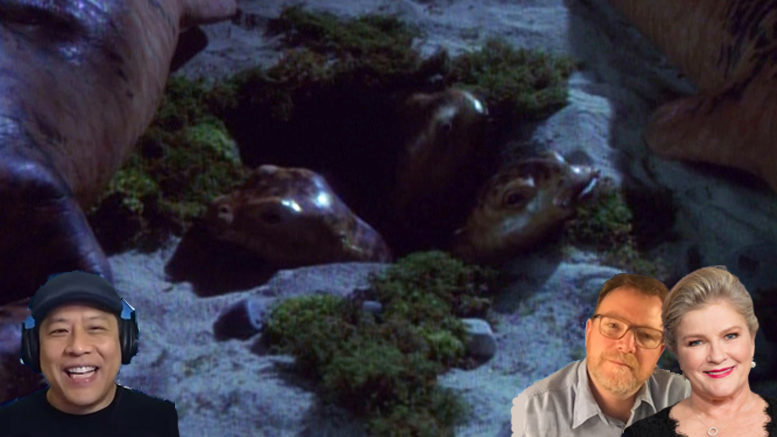
| November 25, 2020 | By: Laurie Ulster 33 comments so far
Ask a fan to name one of the worst episodes in Star Trek history, and Voyager ’s “Threshold” is bound to come up almost immediately. This much-maligned second-season episode, later described by its writer Brannon Braga as “ a royal, steaming stinker ,” is famous for what happens after Tom Paris crosses the Warp 10 threshold: He transforms into a monstrous creature, then kidnaps Captain Janeway and takes her to a planet where they turn into salamanders and have babies before they’re rescued and restored. There was even an action figure from Playmates , complete with three lizard babies, described on the package as “mutant offspring.”
Garrett Wang and Robert Duncan McNeill finally got to “Threshold” in the latest episode of their weekly podcast The Delta Flyers , where they are making their way through the entire series in chronological order. Earlier this year McNeill told TrekMovie that while he was happy with his work on “Threshold,” it was the only episode he wasn’t looking forward to discussing, but Wang rightly pointed out that fans likely felt the opposite.
Kate Mulgrew joined the pair with some extra commentary in the Patreon-only section of the podcast to reminisce about filming her scenes and speculate on how salamanders might copulate. Here are some of the highlights of their lively discussion, including the audio from the non-Patreon part of Robbie and Garrett’s discussion.
The award-winning makeup had its challenges
Mulgrew asked (sincerely) if the episode had won “a lot of awards,” and while McNeill joked that it won the award for “maybe the worst episode of Star Trek: Voyager ever made,” it did, in fact, win an Emmy for Outstanding Makeup for a Series—and the episode deserved it.
From McNeill’s description of filming his scenes as Tom Paris mutated, it sounds like he should’ve shared in that award along with Michael Westmore and his team. None of it was easy, starting with the menthol that was blown into his eyes to irritate them so they’d be bloodshot.
McNeill reported that when he filmed the scenes where he was losing his ability to breathe in Voyager’s atmosphere, it triggered his sense memories of having asthma attacks. He imitated them as a way to get into the scene, but his body picked up on what he was doing and he started to have the anxiety and tightness in his chest that always accompanied his attacks, so severely that rewatching it brought back all those feelings vividly. (In fact, he had once had an attack so severe during a different episode that they had to delay filming so he could go to the hospital.)
He also said it was difficult to act once the makeup reached its peak.
They had tubes that went down my legs, and they were sitting on the floor, like three feet away from me, literally they were going (blows), blowing these bladder balloons. So all I could hear inside of the rubber, I could barely hear the actors, I looked at their lips moving.
As for the horror movie-type scene where Paris’ tongue fell off:
That tongue was made of silicone. But then they put some other jelly, red, like Jell-O, so that it looked like it was sort of just collapsing or falling apart. So I did have some red Jell-O, and I had that silicone tongue, rubber tongue, had to get in my mouth… it was a lot of stuff for that tongue coming out.
And then for the final touch, he used an inky black mouthwash right before they filmed, so the inside of his mouth would appear black—and his real tongue would be harder to see.
Not just character mutation, but character evolution
Despite the episode’s bad reputation, Robbie and Garrett had some positive opinions on it. Wang thoughtfully pointed out that there was more to the changes in Paris than what was seen on the outside as they discussed how Tom changed over the course of the series. McNeill said he “came into the series embodying a lot of toxic masculinity” and Wang said this was embodied in the scene where Paris monologues from his sickbay bed. “You see the vestiges of the toxic masculinity even in this scene,” he said, bringing up Paris’ memories of crying alone as a kid and being told crying was a weakness by his father. ‘This is definitely a transitional phase for Paris to become more of a complete human being,” Wang summed up.
McNeill agreed, and admitted he relished the opportunity to stretch his acting chops.
My memory of making the episode, because I got to play the Elephant Man in a way, I got to play this transformation, this larger-than-life operatic story of the entire character changing, and dying, and coming back to life, and seeing things, having this acid-trip kind of revelations, my memory was, it was a lot of fun to act in. SO it was really satisfying for me as an actor.
Kate Mulgrew talks salamander copulation
Kate Mulgrew made her Delta Flyers debut (on Patreon only) and started off joking over their choice of episodes to discuss.
I was thinking about this last night as I put my little head on the pillow. Of ALL the episodes you could ask me to join you in conversation about, of everything we did together, every conceivable adventure, confrontation, peril, right? You choose “Threshold.” The story of Lt. Paris and Captain Janeway having lizards.
After their enthusiastic YES, she went on.
I didn’t think it was our finest moment, Robbie, but since we’re going to be talking about it, let’s extoll its virtues, okay? Locked in a turbolift with Robbie McNeill is something akin to delightful alcoholism, I should think. Because no aspect of it was based in reality of any kind.
She says she had fun–not always the case for her, given the grueling schedule–and confessed that her makeup had to be reapplied many times because McNeill kept making her laugh, reporting that it was his entire modus operandi as she was “..trying desperately to give birth to 25 lizards.”
While they made fun of the episode, they all acknowledged their admiration and respect for writer Brannon Braga and director Alexander Singer. Mulgrew’s theory is that the team had had so much pressure on them for the first season and a half that they needed a break of sorts, and that’s what they were trying to do with “Threshold,” but “…in so doing everybody lost their mind.”
Mulgrew asked where Harry was during all of this, since Ensign Kim wasn’t, as McNeill thought he should be, “sobbing inconsolably” in Sickbay as Paris suffered and died; she told Wang he must have been “off on your shuttlecraft, looking for the lizards that had escaped.”
Amidst all their laughter, McNeill said that he thought there was a “grain of a really interesting science fiction idea” in there, about becoming one with the universe simultaneously, describing it as “ kind of like an acid trip, in a way, I would imagine.”
“I think if we’re going to be very frank, I would’ve preferred an acid trip,” Kate replied, cracking up her co-stars. “That’s very lofty thinking.”
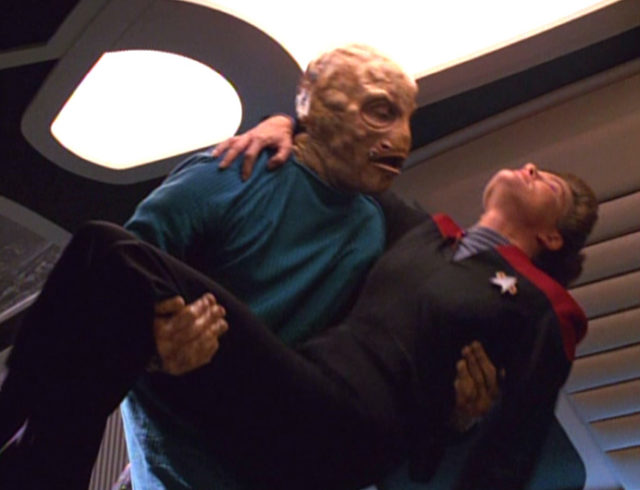
Who says romance is dead?
Wang pointed out “Threshold” was significant for being the only episode where Captain Janeway has sex, albeit as a salamander.
This is the first time and probably the only time that she has that. And also later, when you guys are back to human form… you’re both in Sickbay, and he looks at you very sheepishly, and he’s like, “Um, yeah, I’m sorry.” ‘Cause he still has knowledge that he had the intercourse with you. And then you, Kate, you look back at Robbie, you say, “Well you know, it’s all right, Mister Paris, but you do know that in a lot of different species, it’s the female that initiates the intercourse.” … It was almost, to me, a flirtation.
“That’s exactly right,” said Mulgrew. “Janeway did have a sense of humor, Garrett. And she often expressed it with Lieutenant Paris.”
“But,” she added, “ it does beg the question: I know that scientists will answer this… has anybody actually seen salamanders copulating? Have you guys ever actually witnessed it?”
McNeill chimed in, amidst their laughter, with “I will admit I did not do that research, Kate.”
Mulgrew doubled up.
I don’t think they copulate in any kind of way that could be confused with sexual intercourse. I don’t think there’s a great deal of, shall we say, foreplay.
“Tenderness, no,” posited McNeill, as Mulgrew ran with it:
Romantic pep talk? Erotic suggestions? I think they just slither on, and slither off.
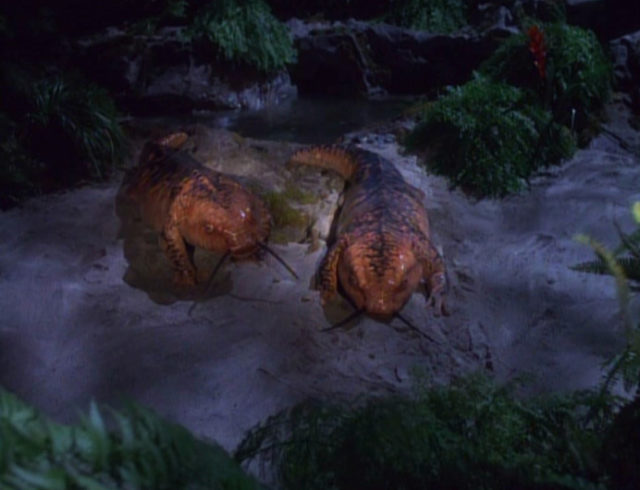
Janeway and Paris, slithering
Listen to The Delta Flyers on “Threshold”
For more exclusive interviews plus an extended version of the podcast and more, become a Patreon subscriber .
Keep up with the Star Trek celebrity news at TrekMovie.com .
Related Articles
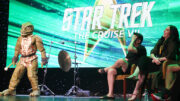
Conventions/Events/Attractions , Discovery
‘Discovery’ Panel Hints “Something Special” In Season 5, Gorn Gong Show, And More Star Trek Cruise Day 7
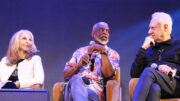
Conventions/Events/Attractions , Star Trek Universe TV , Star Trek: Legacy , Star Trek: Picard , TNG , Trek on TV , Upcoming TV projects
‘Picard’ Cast Talks “Cozy” Enterprise-D, Gates Hosts “Genesis” Watch Party, And More Star Trek Cruise Day 6

Conventions/Events/Attractions
Orchestral “Darmok,” Celebrity D&D, Ken Mitchell Memorial Rave, And More Star Trek Cruise Day 5
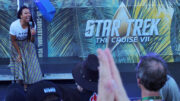
Star Trek Cruise Log: Day 1 Kicks Off With A Party On The Pool Deck And A Dancing Gorn
TOS : Spocks Brain TNG : Shades of Gray DS9 : Fascination VOY : Threshold DSC : * no comment *
ENT: “A Night in Sickbay”
But “Threshold” really isn’t the worst episode of Voyager by far, I’d but quite a few others in its place.
Oh i forgot ENT definitely Storm Front 1 and 2 !
I’d have to say “Once Upon a Time” is the worst.
Agreed on DSC. DSC has been very good so far.
For Enterprise, the Klingon Retrovirus eps were just horrible — the fan service was so obvious and forced.
TNG — Encounter at Farpoint and Unification — not that they were the worst, but given they were hyped so much, they were just such a disappointing letdown that it bothers me to this day.
TOS: Spocks Brain – yeah, that’s really a no brainer! :-D
TNG: why does everyone have issues with Shades of Gray? I loved all the flashbacks when I first saw it. Sure, it’s not the most creative kind of money-saving show, but I didn’t realize it at the time, and so I still like it. I’d probably pick Code Of Honor instead, though even that isn’t totally bad. In fact I’m rewatching season 1 right now, and I don’t find it nearly as bad as I thought it was…
DS9: haven’t watched alle episodes yet, so I don’t know about Fascination right now, but probably something from the first two seasons. Or anything with Sisko without the beard and with hair ;-)
VOY: agreed, there are a lot of episodes that are worse than Threshold. Sure, the salamander stuff is goofy, but the warp 10 concept was interesting, and overall it was done very well, I would say.
ENT: hmm, yeah, probably A Night in Sickbay, though that’s a nice Phlox story. Storm Front was hilarious, though, so probably that.
DSC: almost every episode, sorry.
I’d imagine Shades of Grey works better on the first run through the series but afterthat its utterly pointless and totally skipable. The thing is, a bottle show could have been done in far more original ways without any need for any SFX. Something maybe like a courtroom drama episode or a an episode where Picard sits in his quarters and talks about his life for 40 minutes to Wesley or something lol…
TOS: Spock’s Brain TNG: Code of Honor DS9: Move Along Home VOY: Threshold ENT: A Night in Sickbay DSC: *jury still out*
There, fixed your list “Tim”
Trek Worst List…
TOS: And the Children Shall Lead TNG: Sub Rosa DS9: Profit and Lace VOY: Threshold ENT: Unexpected DSC: Si Vis Pacem, Para Bellum PIC: The End is the Beginning LDS: Moist Vessel
Agree with And the Children Shall Lead. Spocks Brain is stupid, but it’s kind of silly good.
But Threshold is the worst
For me, the worst Voyager episode was Tsunkatse. The network was using the show as a blatant promo for The Rock.
So, Warp 9.99 is still the speed limit in the 32nd century, or are anti-mutation shields standard issue?
It looks like they use quantum slipstream technology now.
For me personally, the episode would have been do much better off what they were apparently trying to discuss, really occured. I mean for all these astonishing situations (crossing warp 10, unifying with Universe, dying, resurrection, turning info something completely different) informed character growth. I’m often saying that Star Trek isn’t a soap opera, it shouldn’t rely so hard on characters backstory, romances (like Discovery did on the first season or two), because no matter how good the characters are they shouldn’t be overshadowing what the franchise is (should) be about – you know – STAR TREK. By the way – DS9 is for me not an exception, because I consider it to be a great seria, my beloved one amongst those under ST name, but still – not a good Star Trek. With all that said – if you are having an episode od sci-fi where a single character goes through all those great SF situations, you need some context for them to work to make viewers think about how that could be transitioned to human condition. Threshold doesn’t give you enough of this on this almost Kafka’esque story and this is, in my opinion, why it gets what it deserves on the discussion boards.
This episode was awkward but I liked it.
If Tom Paris’ insubordinations are so-called “male toxicity”, maybe someone can enlighten me what to call Michael Burnham’s far more consequential insubordinations (not to forget her stereotypical inability to keep her emotions in-check, as behooves a professional officer and scientist)? At least Tom Paris didn’t start a mutiny that resulted in an interstellar war…
Um… not his insubordinations. More his constant hitting on women, which started in the very first episode. I recommend you listen to the Delta Flyers podcast, Garrett and Robbie have a great conversation about it.
Other than Thirty Days when was Paris insubordinate? That whole Season 2 arc was all a subterfuge, he wasn’t really being insubordinate.
I love Voyager and her crew to death but Threshold makes Spock’s Brain look like an Emmy winning episode. It’s just SO bad! I’ve only seen it twice to this day.
But these guys, Mulgrew especially, seem to have a good laugh about it. It’s nice they can just reminisce about the more awful stuff and not sound bitter about it.
Well, I’ve never got that hatred for “Threshold”. It was a mediocre, paint-by-numbers episode, forgettable and bland, but it’s not nearly as bad as some people want into to be. The worst episode was “Course: Oblivion”. I simply couldn’t stand the bleak, depressive resolution.
As for TOS: “Spock’s Brain” is campy fun but also by far not the worst of them. I really disliked “The Omega Glory” and “Plato’s Stepchildren”, though that kiss made TV history. But actually I liked “And the Children Shall Lead”. It has a certain “Children of the Corn” feeling, decades before those movies were made.
TNG… I don’t know. “Shades of Grey” was a filler with flashbacks that came for too early to be effective. I would have loved to see this in Year 7 with all of the series being covered. But again, it wasn’t bad at all. There are hardly any superbad TNG episodes. I like “Sub Rosa”. It’s not great but not bad either. I wasn’t a big fan of “Lessons”, but it wasn’t a stinker, just not particularly interesting.
ENT… Sickbay is okay with me. The worst disappointment was “These Are the Voyages” but only because they made it the series finale. As a standalone entry, it would have been quite neat.
DSC… Not a big fan of the rushed S1 finale but again, not a total loss. I have no DSC episode I totally dislike though I take issues with some scenes, especially the excessively bloody ones.
PIC… That’s why I hate “Stardust City Rag” for it’s Icheb opener.
Wow. I think Course: Oblivion is excellent. Especially on first watch, when we didn’t know what was going on. Parallel universe? Bad dream? I never saw the link to Demon coming.
Am I the only one who actually really liked this episode? I remember I watched it several times.
Very possibly, yes. I’ve never seen a “worst episode ever” list where Threshold was not near the top.
I loved A Night in Sickbay on ENT, thought it was a fun episode!
It was okay. I never understood the hate for it, either. It is just kinda there, neither good nor bad IMHO.
It’s not completely true that this is the only episode where Janeway has sex. In Fair Haven she most likely has sex with one of the holodeck characters, Sullivan. Chakotay even admits to having sex on the holodeck himself! And now that I’m thinking about this there’s another epispode… Janeway and some of the crew are abducted and brainwashed in two parter Workforce. Janeway meets a co-worker, Jaffen (love that name!), and decides to move in with him. I mean, c’mon! Either way, she has her fun more than once on the show. While sexuality is not required to make a show good, I think it’s good for her character and the show.
Definitely in Workforce! But that hadn’t happened yet, so I guess this is the FIRST time on the show? (I love Workforce.)
As it happens, Salamander “foreplay”, which in this case means things the male does to get the female ready to mate, is much longer than typical human foreplay. But it’s instinctive in nature, we can’t really say it’s “fun” for them.
The dumbest part is that because the condition was reversible, they could have adapted the ship, went home, and reversed it.
Don’t know why Voyager got a bad rep in Trek social circles. Was the best out the lot of them. I even thought there would be a spin off series when she meets the Federation Timeship of the future. Not just boldly going in space but also in time. I would’ve watched that. Big up all the cast and Crew of the USS Voyager.. Cmon guys. Enuf reminiscing. As old as they are now, I’d still watch new episodes any day. 😉
For me, the worst episode of Voyager is “The Fight”. It was the only episode that was such a struggle to get through. Interesting idea, but the execution was just awful. I felt embarrassed for the actors, especially Chakotay
I think I agree with you! I hated “The Fight” and “False Profits.” Those were the weakest ones in my book. “Threshold” is still entertaining, and Robert Duncan McNeill did a great job with it.
- Why I'm Boldly Going
- What's Going On Here
- Generic Ensign
Friday, September 20, 2013
Voyager: threshold.

7 comments:
I always wondered why they didn't bring the babies back and turn them into humans, if they could turn Tom and the Captain back. Now that would have been an interesting plot twist!
Kellie, I KNOW! It seems ridiculous that they literally just desert Tom/Janeway's infant offspring to fend for themselves on an unknown planet in the Delpha Quadrant. But really, I think at that point everyone was just kind of washing their hands of the situation.
Whenever I see this episode I wonder if the writer accidentally ingested some hallucinogenic mushrooms or something 3/4 of the way through writing the script--and thus, the salamanders. Alternatively, the writer could have left the script laying around and his kid sat down and wrote the rest of it. I think they left the salamander kids behind because no one wanted to be reminded of what transpired on that island. What happens on random planets in the Delta Quadrant, stays on random plants in the Delta Quadrant.
I remember the episode but at the same time I don't remember it so maybe it is just that episode........
This one is just weird. Not to mention Kirk's Enterprise exceeded warp 10 several times, going up to 13 once. They never turned into salamanders. Maybe it has something to do with Delta Quadrant mojo.
If you don't remember this episode... chances are you've blocked it to spare yourself trauma. That last quarter of the episode quite efficiently renders the entire episode "terrible". And not even in a "so-bad-it's-good" kinda way. Sadly every time I see this one, I think of the premise being really neat until Tom goes all "cranky salamander". Even Brannon Braga (writer of "Threshold") admits it was terrible, which takes a lot of humility in my opinion. I rank this one up there with DS9's "If Wishes Were Horses", and that episode of TNG where Troi is a cake. Sometimes there's a stinker (of the "500-cow-dairy-farm" variety) in the bunch.
Incidentally, I love that picture of Picard and Riker doing the synchronized face-palm. lol
- Show Spoilers
- Night Vision
- Sticky Header
- Highlight Links

Follow TV Tropes
http://tvtropes.org/pmwiki/pmwiki.php/Recap/StarTrekVoyagerS2E15Threshold
Recap / Star Trek: Voyager S2E15 "Threshold"
Edit locked.

Here lies Thomas Eugene Paris. Beloved mutant.
This episode provides examples of
- Aliens Made Them Do It : Paris and Janeway are accidentally transformed into nonsapient animals, mate and produce a litter of offspring. Probably the most bizarre way of getting two main characters to make out in sci-fi history!
- Artistic License – Biology : The episode features a notoriously bad depiction of evolution . According to the script, not only can individual beings evolve into a completely different form, but the path of that evolution is laid out by fate.
- The Atoner : Tom thinks that being the first to breach the Warp 10 barrier will make up for his being a failure in life.
- Big "NO!" : Tom shouts one as he begins his transformation.
- Body Horror : Paris's mutation causes his DNA to break down, gradually making him look less human and more alien. At one point, he spits out his tongue , thus making talking difficult for him. Unsurprisingly, the episode won the Emmy for Best Makeup Effects.
- Contrived Coincidence : Warp 10, according to this episode, makes you somehow everywhere in the universe at once. So how convenient that Tom rematerializes right back near the ship! And on mutant!Tom's second attempt with Janeway, they just wind up on a nearby planet, makin' salamander babies.
- Cool Ship : The squat Type 6 shuttlecraft is replaced by the sleek Class 2, dubbed the 'Speedboat Shuttle' by the production staff and fans.
- Creator Provincialism : Janeway says Tom will be joining the likes of Orville Wright, Neil Armstrong, and Zephram Cochrane. Many viewers noted the oddity of her not mentioning the actual first man in space, Yuri Gagarin. Not to mention that all of these are Humans.
- Danger Room Cold Open : The episode opens with Tom in a shuttlecraft that breaks up as he hits the Threshold. We then cut to Tom sitting on the floor of the holodeck . B'Elanna: You're dead.
- Death Is Cheap : Tom dies, his cells so damaged the Doctor doesn't try to revive him past the first attempt . Then he comes back to life again. He and Janeway mutate into lower lifeforms and are brought back to perfect health.
- Easily Forgiven : Tom Paris because he was literally Not Himself at the time, what with being a catfish and all. As for the kids, Janeway jokes that it might have been her idea.
- Famous, Famous, Fictional : Janeway tells Tom that by being the first man to breach the Warp 10 barrier, he'll be joining the ranks of Orville Wright, Neil Armstrong, and Zefram Cochrane. This case differs from the usual trope in that Cochrane is from already established Trek canon (he invented the warp drive on Earth, and thus the Vulcans decided it was time for First Contact ), rather than a completely made-up name.
- Foreshadowing : Janeway says that the ability to fly at warp 10 will change the nature of humanity's existence. Yeah, turning into a catfish will do that...
- Forgotten Phlebotinum : Even ignoring the lizard-fication, it's mentioned that the experimental shuttle's computers were jam-packed with helpful navigation aids and maps — which are never mentioned again.
- Formerly Sapient Species : Tom Paris's "accelerated evolution" into a non-sapient salamander-like creature. The writer of this episode has stated that his idea was that in the distant future, humanity would evolve beyond the need for sapience due to technology providing for all our material needs.
- FTL Test Blunder : Paris figures out transwarp traveling, which might get the ship back to the Alpha Quadrant. After a seemingly successful test, he has an allergic reaction to water and starts de-evolving into a salamander/lizard/catfish creature. And then things get very weird.
- Golden Moment : At the end of the episode, Tom realises that doing something famous is not going to solve his issues.
- Gone Horribly Wrong : Just for starters, Tom, upon returning to the ship, becomes allergic to water. Somehow, it goes downhill from there.
- If I Do Not Return : Tom's last words before he (temporarily) dies. Tom: Do me a favor. When I'm gone, call Starfleet Headquarters and tell Dad that I did it. Tell him...
- I Just Want to Be Special : What drives Tom into this whole mess.
- Impossible Genius : Quite a few reviewers wondered why the crew didn't just transwarp back to the Alpha Quadrant regardless , given the Doctor's miraculous ability to restore them from an amphibious state. Though given the stress the transwarp flight put on the shuttle, it's possible Voyager wouldn't have survived.
- The Infinite : Tom Paris designs and builds an engine to go To Infinity And Beyond!! As a drive the infinite turns out to be improbable though.
- Just Think of the Potential! : Why, they could get home instantaneously, change space travel forever, but most of all, let Tom work out his daddy issues!
- Last Kiss : Tom asks for a last kiss from Kes, but she points out that he'll die if they let down the medical forcefield. After Tom dies anyway, a distraught Kes kisses him on the cheek.
- Subverted when we find the reason Tom found Neelix's special blend so disgusting is that he's allergic to the water due to the changes in his body.
- Ludicrous Speed : Doesn't even begin to describe it.
- Men Don't Cry : According to Admiral Paris, apparently. Tom doesn't buy it.
- Mistaken for Gay Tom: Kiss me! Doctor: What?! Tom: (indicating Kes) Not you! Her!
- The Mole : Judas...err Jonas transmits details of the Warp 10 experiments to the Kazon. Unfortunately they didn't turn themselves into catfish trying it out.
- Tom is shouting "I'm breaking up!" accompanied by Explosive Instrumentation , then we Smash Cut to B'Elanna and Harry looking bored on the holodeck, with Tom sitting on the floor.
- Tom himself is this In-Universe ; he goes from afraid to angry, to meek and pleading then back to belligerent again, sometimes mid-sentence.
- Mundane Solution : After the Doctor confirms Tom is only unconscious, Janeway says to wake him up. Instead of the expected hypospray of stimulant, Doc leans down to his ear and shouts, "Wake up, Lieutenant!"
- Not Himself : Mutant!Tom lashes out verbally at Captain Janeway, accusing her of wanting him dead as he's an embarrassing failure.
- Ominous Hair Loss : Right after coming back from the dead, Tom finds himself losing clumps of hair, the prelude to the next stage of his mutation.
- Our Dark Matter Is Mysterious : One of Neelix's anecdotes about losing a nacelle passing through a dark matter nebula gives Tom and Harry inspiration to finish their transwarp drive.
- Screw This, I'm Outta Here : Chakotay, having retrieved Janeway and Paris, apparently decides this about the lizard babies.
- Ship Tease : This episode marks the first time its hinted that B'Elanna may be starting to consider Tom more than a crewmate.
- Passing through all points of the universe simultaneously, causing ridiculous things to happen, sounds a lot like the Infinite Improbability Drive . Well, it did turn Ford into a penguin... but he got better.
- Tom comes back to life with a changed face and two hearts .
- Snark-to-Snark Combat Paris: You're losing me, aren't you? I'm going to die. Doctor: You're too stubborn to die, Mr Paris. Paris: Here lies Thomas Eugene Paris. Beloved mutant. Doctor: A fitting epitaph, but I don't intend to let you use it just yet.
- Snowy Screen of Death : Mutant!Tom's escape is only shown by Doc and Kes watching it on the viewscreen . Phaser beams can be seen cutting across Engineering until one knocks out the screen.
- Swiss-Cheese Security : Tom is able to break out of his chamber, take out the security officers guarding him, screw up the internal sensors, abduct Captain Janeway and steal the Warp 10 modified shuttle without any problems. And all this after Tuvok promised Janeway there wouldn't be any more shuttle-stealing incidents in " Maneuvers ".
- Tainted Veins : When Tom first collapses in the canteen.
- Take Our Word for It : The mutated Tom breaks out of his restraints and starts a huge fight with the security team. None of this event makes it on-screen. Instead we have Torres telling the Doctor what is happening.
- Techno Babble : When Tom and Harry have their "Eureka!" Moment . Neelix: I have no idea what they just said.
- That Didn't Happen : Chakotay wonders how the hell he's going to explain in the log that a Starfleet officer abducted the captain, evolved into a lower lifeform and had babies with her. Captain Janeway however takes the matter in stride, suggesting the sex might have been her idea.
- Timey-Wimey Ball : Implied with Tom's incoherent explanations. "The present, the past, they're both in the future. The future is in the past."
- Title Drop : "I'm approaching the Threshold!"
- Too Much Information : Tom discusses how he lost his virginity at 17 while his parents were out of the house. Doctor: I'll...note that in your medical log.
- Too Strange to Show : What Past-Warp-10 looks like. We only see Tom's face when he does it the first time, and the second time, we only see the multi-colored streaks of hundreds and thousands of stars streaking by at super-warp, before the screen fades entirely to white.
- Touch of the Monster : Mutant!Tom carrying Janeway in his arms as he places her in the shuttle.
- Unable to Cry : Tom says that B'Elanna won't be crying at his funeral as she never cries.
- Weaksauce Weakness : Super-evolved catfish things get put down pretty quickly by basic phaser fire.
- "Well Done, Son" Guy : Tom's last words before he dies are to let his father know he crossed the Threshold.
- What Happened to the Mouse? : We see the mutant children of Tom and Janeway enter the slimy pool and...they're never mentioned again.
- Whole-Plot Reference : Brannon Braga wrote the episode as a homage to David Cronenberg 's The Fly .
- You Cannot Grasp the True Form : Tom finds it difficult to explain what traveling through every point in the universe is like.
- You Talk Too Much! : Not imminent death, mutation, or even the loss of a tongue stops Tom from rambling away. Tom: Doctor, I need to talk! Doctor: So I've noticed.
Chakotay: I... don't know how I'm going to enter this into the log. Tuvok: I look forward to reading it.
- Star Trek Voyager S 2 E 14 "Alliances"
- Recap/Star Trek: Voyager
- Star Trek Voyager S 2 E 16 "Meld"
Important Links
- Action Adventure
- Commercials
- Crime & Punishment
- Professional Wrestling
- Speculative Fiction
- Sports Story
- Animation (Western)
- Music And Sound Effects
- Print Media
- Sequential Art
- Tabletop Games
- Applied Phlebotinum
- Characterization
- Characters As Device
- Narrative Devices
- British Telly
- The Contributors
- Creator Speak
- Derivative Works
- Laws And Formulas
- Show Business
- Split Personality
- Truth And Lies
- Truth In Television
- Fate And Prophecy
- Edit Reasons
- Isolated Pages
- Images List
- Recent Videos
- Crowner Activity
- Un-typed Pages
- Recent Page Type Changes
- Trope Entry
- Character Sheet
- Playing With
- Creating New Redirects
- Cross Wicking
- Tips for Editing
- Text Formatting Rules
- Handling Spoilers
- Administrivia
- Trope Repair Shop
- Image Pickin'
Advertisement:
Memory Beta, non-canon Star Trek Wiki
A friendly reminder regarding spoilers ! At present the expanded Trek universe is in a period of major upheaval with the continuations of Discovery and Prodigy , the advent of new eras in gaming with the Star Trek Adventures RPG , Star Trek: Infinite and Star Trek Online , as well as other post-57th Anniversary publications such as the ongoing IDW Star Trek comic and spin-off Star Trek: Defiant . Therefore, please be courteous to other users who may not be aware of current developments by using the {{ spoiler }}, {{ spoilers }} OR {{ majorspoiler }} tags when adding new information from sources less than six months old (even if it is minor info). Also, please do not include details in the summary bar when editing pages and do not anticipate making additions relating to sources not yet in release. THANK YOU
- Memory Beta articles sourced from comics
- Memory Beta articles sourced from reference works
- Measurements
- View history
The warp 10 barrier is a theoretical barrier for a starship with warp drive . Warp 10 is regarded as infinite velocity, so theoretically any vessel travelling at warp 10 would exist at all points in the universe at once, the scale is asymptotic, so Warp 9.99999 is many times faster than just Warp 9.9
- 1.1 Alternate reality
- 2 Background
- 3 External link
History [ ]
In 2267 , the USS Enterprise exceeded warp 10 (old scale) during its encounter with the Nomad probe . Upon hearing that the ship was traveling at over warp 10, Montgomery Scott stated that it was impossible. ( TOS episode : " The Changeling ")
Later that year, the Enterprise was attacked by an Orion scout ship that was traveling at close to warp 10. ( TOS episode : " Journey to Babel ")
In 2268 , the Enterprise once again approached warp 10, after being commandeered by Bele . ( TOS episode : " Let That Be Your Last Battlefield ")
The Daystrom Institute 's transwarp project was designed to break the warp ten barrier. Torias Dax was critically injured during a test of the technology aboard the shuttlecraft Infinity . ( DS9 - The Lives of Dax short story : " Infinity ")
In 2364 , the USS Enterprise -D travelled at speeds nearing warp 10 when it was caught in a gravimetric wave . It was only able to break free by using the slingshot effect . ( TNG - The Space Between comic : " History Lesson "). It also appeared to travel in excess of Warp 9.99999 repeating during the Kosinski experiments ( TNG - " Where No One Has Gone Before ")
In 2372 , the warp 10 barrier was broken by Lieutenant Tom Paris using the shuttlecraft Cochrane and a rare form of dilithium that was discovered in the Delta Quadrant by the USS Voyager . While Paris successfully broke the barrier, it was later discovered that the effect caused hyper-evolution in the humanoid body, and later tests were abandoned. ( VOY episode : " Threshold ")
Alternate reality [ ]
In the Kelvin timeline created by Nero , Section 31 agent, Lieutenant John Harrison was able to revamp the USS Vengeance 's warp drive to give it unprecedented capability. Lieutenant Yuki Sulu estimated that Harrison's work made it possible for Vengeance to get close to warp 10. ( TOS - Khan comic : " Issue 4 ")
Background [ ]
The Enterprise 's rate of speed on stardate 5630.7, estimated at the "old scale" of warp factor eleven, is approximately warp 8 by 24th century standards. ( TOS episode : " Is There in Truth No Beauty? ", ST reference : The Star Trek Encyclopedia )
By the 25th century , in an alternate universe warp (or transwarp ) engines have the capability to reach factors in excess of Warp 9.99999. Other drives such as a Transwarp Drive and Quantum Slipstream drive use a different scale. ( TNG episode : " All Good Things... ")
External link [ ]
- Warp 10 article at Memory Alpha , the wiki for canon Star Trek .
- 1 Ferengi Rules of Acquisition
- 2 The Chase
- 3 Preserver (race)
A specially-outfitted warp-capable shuttlecraft piloted by Tom Paris successfully reaches Warp 10, breaking the transwarp barrier. But the side effects of breaking the barrier may cost the crew of Voyager their best helmsman.
In this episode of the podcast, Wes and Clay discuss “Threshold” and violating canon. Plus! The guys chat about infamous Star Trek episodes, Lynch versus Cronenberg, and hard outs.
- Post author By Wes
- Post date 10/11/2022
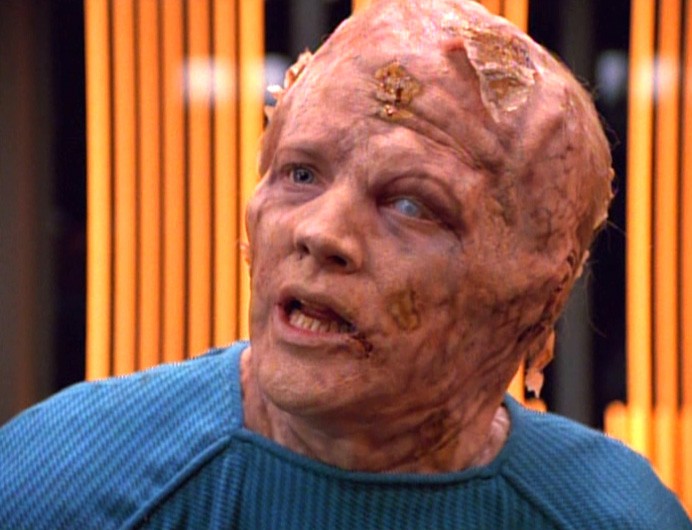
Subscribe: Apple Podcasts | Spotify | RSS | More
Ah, that sacred rule of Star Trek: the “Threshold” of Warp 10. A barrier that cannot be broken. A foundational rule that grounds the universe and franchise in hard science and Newtonian physics. Or… space salamanders. It’s one of those two options.
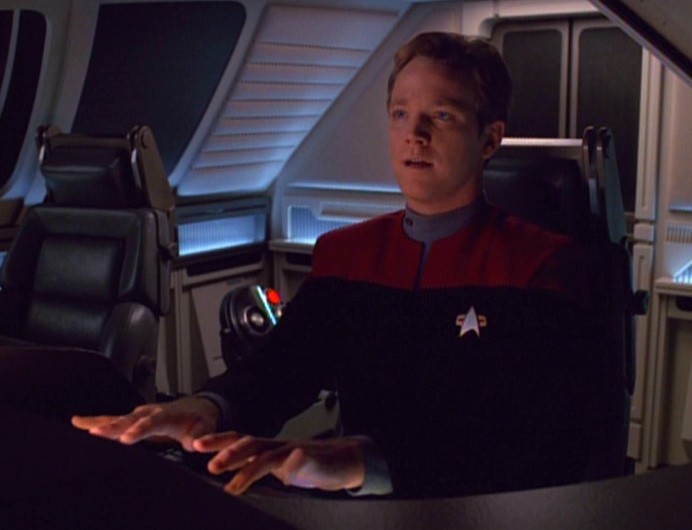
The Wikipedia plot summary for “Threshold”:
Voyager ‘s crew discovers a rare, more stable form of dilithium that they postulate could power a warp drive beyond Warp 10 . This would allow Voyager to reach the Alpha Quadrant near instantaneously. Although holodeck simulations prove disastrous, Lieutenant Paris ( Robert Duncan McNeill ) comes up with an idea after an off-the-cuff discussion with Neelix ( Ethan Phillips ). The next simulation is successful and a shuttlecraft , dubbed the Cochrane , is prepared for a full test flight. The Doctor ( Robert Picardo ) identifies a rare medical condition in Lieutenant Paris indicating a 2% chance that he will suffer lethal effects from the test-flight and recommends assigning Ensign Kim ( Garrett Wang ) as test-pilot. Paris convinces Captain Janeway ( Kate Mulgrew ) to allow him to fly the shuttle despite the small risk.
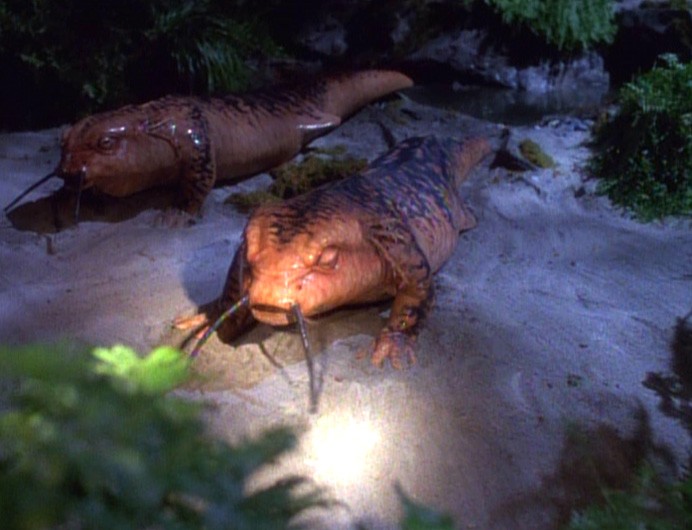
Paris successfully breaks the Warp 10 barrier with the Cochrane , rapidly disappearing from Voyager ‘s sensors. The crew begins to try to track the shuttle, but soon the Cochrane reappears, Paris unconscious at the controls. Once awake, Paris explains that he had already seen everything at every point in space, and the shuttle’s database similarly contains a massive amount of information about the Delta Quadrant . However, Paris starts to suffer allergic reactions, and he is raced to Sickbay , where the Doctor determines that Paris is now allergic to common water. Paris’s body soon changes again, and no longer can process oxygen, forcing the Doctor to create a special environment that Paris can exist in.
Paris’s body continues its strange transformations, the Doctor postulates that he is becoming a new form of life. Before the Doctor can use an “anti-proton” treatment to return Paris to his human form, Paris escapes, disrupts Voyager ‘s internal systems, and kidnaps Janeway on the Cochrane . After the crew repairs Paris’ damage, the Cochrane has taken off to Warp 10. As Voyager follows the shuttle’s trail, they come to a planet covered in swamps. The Doctor explains that mutation ‘s in Paris’ DNA are consistent with those of evolution. Near the shuttle, they discover two amphibian beings, with trace DNA of Paris and Janeway. The two mated and had three offspring. The crew members recover a transformed Janeway and Paris. The Doctor returns them to their human forms. The offspring are left behind.
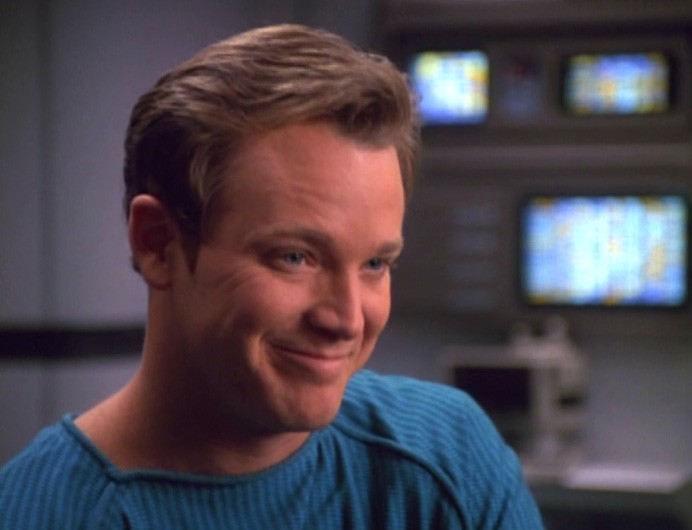
- Cast & crew
- User reviews
- Episode aired Nov 20, 1996

A dying warlord, determined to retake his home planet, takes over Kes's body. A dying warlord, determined to retake his home planet, takes over Kes's body. A dying warlord, determined to retake his home planet, takes over Kes's body.
- David Livingston
- Gene Roddenberry
- Rick Berman
- Michael Piller
- Kate Mulgrew
- Robert Beltran
- Roxann Dawson
- 14 User reviews
- 7 Critic reviews

- Capt. Kathryn Janeway

- Cmdr. Chakotay

- Lt. B'Elanna Torres
- (as Roxann Biggs-Dawson)

- Lt. Tom Paris

- Ensign Harry Kim

- (as Leigh J. McCloskey)

- Alien Waiter
- (uncredited)

- Talaxian Masseuse
- All cast & crew
- Production, box office & more at IMDbPro
Did you know
- Trivia This episode marks the end of Kes and Neelix's relationship.
- Goofs At the start we see Neelix having his foot massaged. It is clearly a 'Talaxian foot'. In Caretaker (1995), his foot is shown to be 'human' looking.
[last lines]
Kes : Everything seems so different now. My thoughts and perceptions... Even my relationships with my closest friends... You, the Doctor, Neelix... How can I go back to my normal life as if nothing ever happened?
Lieutenant Tuvok : You cannot. This experience will force you to adapt. You are no longer the same person, and the course of your life will change as a result. Where that new course leads is up to you.
- Connections Referenced in Treksperts Briefing Room: Warlord (2023)
- Soundtracks Star Trek: Voyager - Main Title Written by Jerry Goldsmith Performed by Jay Chattaway
User reviews 14
- Dec 30, 2022
- November 20, 1996 (United States)
- United States
- Official site
- Paramount Studios - 5555 Melrose Avenue, Hollywood, Los Angeles, California, USA (Studio)
- Paramount Television
- See more company credits at IMDbPro
Technical specs
- Runtime 46 minutes
- Dolby Digital
Related news
Contribute to this page.
- IMDb Answers: Help fill gaps in our data
- Learn more about contributing
More to explore

Recently viewed
- The Inventory
Happy 'Threshold' Day, Star Trek Sickos
Star trek voyager dropped one of its most infamous episodes 28 years ago, but its legacy has been embraced by fans, like the tender arms of amphibian lovers..

Twenty-eight years ago, Star Trek asked a daring question , one fitting of a franchise that triumphs boldly going and facing the unknown: should experimental FTL travel culminate in a captain and her helmsman turning into amphibians and doing the scaly deed? The answer is unequivocally no , but it has given us a reminder that even the worst moments of a franchise as long-lived as Star Trek are occasionally worth re-evaluating.
Related Content
It takes a lot to be a bad episode of Star Trek , and “Threshold” is an easy target when evaluating the many highs and lows of Star Trek Voyager. But the entire episode isn’t without merit, even if we remember it for its insane climax where Captain Janeway and Tom Paris have completely transformed into four-legged space-amphibians and procreated together before the crew can retrieve and un-amphibian them—creating what seems like the mother of all ethical workplace nightmare scenarios. But it’s a nightmare scenario that Voyager moves on from sharpishly, because, well, that’s just what Star Trek Voyager does , even with the good ideas.
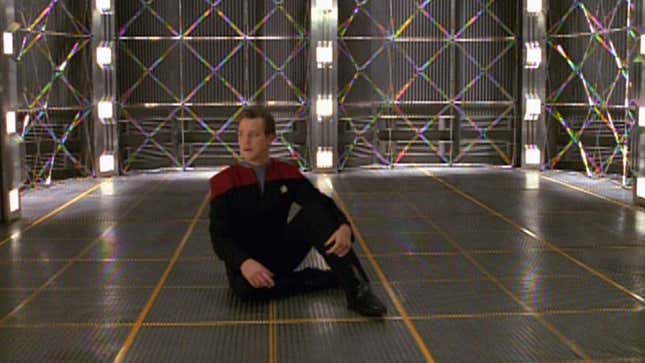
“Threshold” largely deals with the titular threshold pertaining to Star Trek ’s warp travel , and the challenge of putting into practice what would happen if a starship traveled beyond the seeming max speed of Warp 10. It’s a fascinating idea, one that tackles a fundamental pillar of Star Trek worldbuilding—the Warp 10 threshold had existed since the original Star Trek —and plays to the unique context Voyager found itself in. In Robert Duncan McNeill’s Tom Paris, the show had a daring pilot—discharged from Starfleet covering up a piloting error, jailed for joining the guerrilla Maquis group, and now eager to re-prove himself—willing to push boundaries. Voyager had a premise where this kind of specific boundary was begging to be pushed: stranded in the Delta Quadrant hundreds of thousands of lightyears away from home, the crew was desperate to find new ways to shave years off their decades-long journey back. The problems in “Threshold” were never to do with its ideas.
And for the most part it wasn’t to do with the execution, either. After breaking past Warp 10 in trials to find a way to get home quicker, Paris begins slowly but inevitably transforming—at first seemingly mutating, but instead according to Voyager ’s holographic doctor, apparently evolving at a highly accelerated rate. It’s fascinatingly grotesque, as we see Paris slowly melt into this strange, increasingly broken being. The body horror is some of the best Trek has ever done; the scene where a mutilated Paris vomits out his tongue after lambasting Janeway for both taking pity on his grotesque form and accusing her of being jealous of his achievement, regardless of the cost, is remarkably haunting. Once again, all great ideas: effectively creepy, yes, but also a compelling bit of character work for Paris, putting him at the crucible of another accident caused by his own hubris, and seeing how, as the filters that had created the man he’d started to become on Voyager get stripped away, he deals with that scenario again.
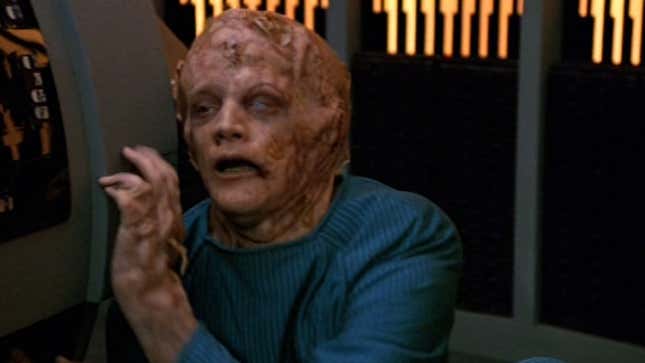
Alas, the answer is “extremely not well,” of course, but before it can really dive into that in a meaningful way “Threshold” gets into the moment that sinks it—the rapidly transforming Paris capturing Janeway, forcing her to undergo transformation herself, and then, yes, the amphibian horizontal tango. There’s a lot of weaknesses here, even putting the unhinged idea that the show’s captain and a senior officer have space-amphibian sex aside. Voyager ’s premise being that it’s so radically far away from the rest of Star Trek , physically speaking, dooms pretty much every episode early on in its run that tackles a premise where the crew get their hopes up about a potential method that could get them back home; every time, you’re inevitably waiting for the other shoe to drop well before it drops on any of its characters.
There’s also the issue of its serialization, where very little actually carries over from one episode of the series to the next—neither Paris nor Janeway ever bring up the events of “Threshold” ever again, to each other or anyone. No one addresses the ethical or moral compromise made, nor the insane implications and ramifications that amphibian Janeway and Paris leave a clutch of purportedly highly evolved human-amphibian-celerity-induced babies to disrupt the ecosystem of a planet they just happened to be passing by. Paris’ arc as a man eager to see himself redeemed by the chance he’s got on Voyager is something that persists over the rest of the show, yes, but no one ever goes into the mask that falls off here ever again.
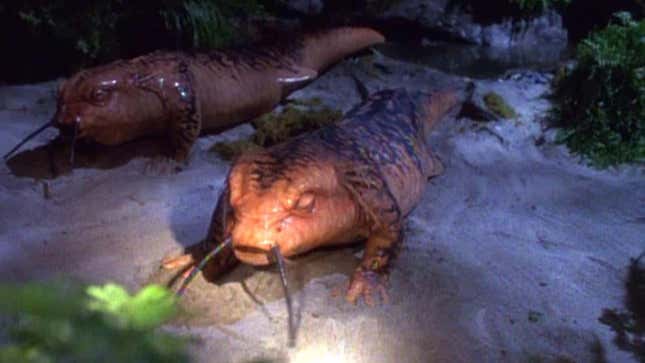
So yes, “Threshold” is a failure of an episode in a lot of ways. And yet, the sheer outlandish goofiness of its climax has led to a softening of that failure nearly three decades later. The amphibians are the source of fan art , of jokes and memes, an earnest embrace that Star Trek can fail but still have a sense of humor about it. It may never truly shake its reputation as one of the worsts of the series, and of the franchise—but the embrace of its camp and its absurdity means that we’ve slowly come around to at least admiring the potential of “Threshold” and its better ideas. And that makes celebrating its anniversary just as fun all these years later, almost as much as taking the piss out of one of the weirdest sex scenes in Trek history is.
Want more io9 news? Check out when to expect the latest Marvel , Star Wars , and Star Trek releases, what’s next for the DC Universe on film and TV , and everything you need to know about the future of Doctor Who .
Advertisement
April 22, 2024
After Months of Gibberish, Voyager 1 Is Communicating Well Again
NASA scientists spent months coaxing the 46-year-old Voyager 1 spacecraft back into healthy communication
By Meghan Bartels
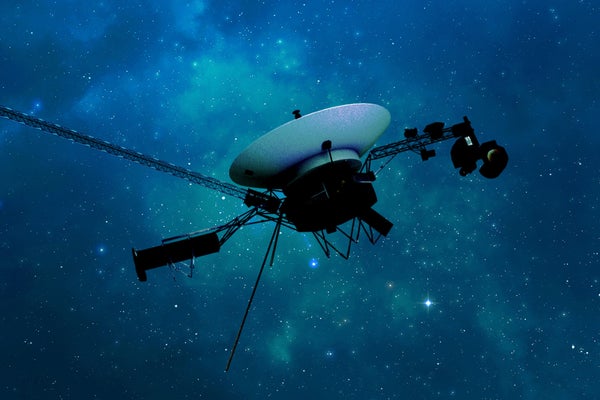
NASA’s Voyager 1 spacecraft is depicted in this artist’s concept traveling through interstellar space, or the space between stars, which it entered in 2012.
NASA/JPL-Caltech
After months of nonsensical transmissions from humanity’s most distant emissary, NASA’s iconic Voyager 1 spacecraft is finally communicating intelligibly with Earth again.
Voyager 1 launched in 1977 , zipped past Jupiter and Saturn within just a few years and has been trekking farther from our sun ever since; the craft crossed into interstellar space in 2012. But in mid-November 2023 Voyager 1’s data transmissions became garbled , sending NASA engineers on a slow quest to troubleshoot the distant spacecraft. Finally, that work has paid off, and NASA has clear information on the probe’s health and status, the agency announced on April 22.
“It’s the most serious issue we’ve had since I’ve been the project manager, and it’s scary because you lose communication with the spacecraft,” said Suzanne Dodd, Voyager project manager at NASA’s Jet Propulsion Laboratory in an interview with Scientific American when the team was still tracking down the issue.
On supporting science journalism
If you're enjoying this article, consider supporting our award-winning journalism by subscribing . By purchasing a subscription you are helping to ensure the future of impactful stories about the discoveries and ideas shaping our world today.
The Voyager 1 spacecraft is a scientific legend : It discovered that Jupiter’s moon Io, far from being a dead world like our own companion, is instead a supervolcanic world . The craft’s data suggested that Saturn’s moon Titan might have liquid on its surface. And for more than a decade, Voyager 1 has given scientists a glimpse at what space looks like beyond the influence of our sun.
Yet its long years in the harsh environment of space have done a number on the probe, which was designed to last just four years. In particular, degraded performance and low power supplies have forced NASA to turn off six of its 10 instruments, and its communication has gotten even spottier than can be explained by the fact that cosmic mechanics mean a signal takes nearly one Earth day to travel between humans and the probe.
When the latest communications glitch occurred last fall, scientists could still send signals to the distant probe, and they could tell that the spacecraft was operating. But all they got from Voyager 1 was gibberish—what NASA described in December 2023 as “a repeating pattern of ones and zeros.” The team was able to trace the issue back to a part of the spacecraft’s computer system called the flight data subsystem, or FDS, and identified that a particular chip within that system had failed.
Mission personnel couldn’t repair the chip. They were, however, able to break the code held on the failed chip into pieces they could tuck into spare corners of the FDS’s memory, according to NASA. The first such fix was transmitted to Voyager 1 on April 18. With a total distance of 30 billion miles to cross from Earth to the spacecraft and back, the team had to wait nearly two full days for a response from the probe. But on April 20 NASA got confirmation that the initial fix worked. Additional commands to rewrite the rest of the FDS system’s lost code are scheduled for the coming weeks, according to the space agency, including commands that will restore the spacecraft’s ability to send home science data.
Although, for now, Voyager 1 appears to be on the mend, NASA scientists know it won’t last forever. Sooner or later, a glitch they can’t fix will occur, or the spacecraft’s ever dwindling fuel supply will run out for good. Until then NASA is determined to get as much data as possible out of the venerable spacecraft—and its twin, Voyager 2, which experienced its own communications glitch earlier in 2023 .
- International edition
- Australia edition
- Europe edition

Voyager 1 transmitting data again after Nasa remotely fixes 46-year-old probe
Engineers spent months working to repair link with Earth’s most distant spacecraft, says space agency
Earth’s most distant spacecraft, Voyager 1, has started communicating properly again with Nasa after engineers worked for months to remotely fix the 46-year-old probe.
Nasa’s Jet Propulsion Laboratory (JPL), which makes and operates the agency’s robotic spacecraft, said in December that the probe – more than 15bn miles (24bn kilometres) away – was sending gibberish code back to Earth.
In an update released on Monday , JPL announced the mission team had managed “after some inventive sleuthing” to receive usable data about the health and status of Voyager 1’s engineering systems. “The next step is to enable the spacecraft to begin returning science data again,” JPL said. Despite the fault, Voyager 1 had operated normally throughout, it added.
Launched in 1977, Voyager 1 was designed with the primary goal of conducting close-up studies of Jupiter and Saturn in a five-year mission. However, its journey continued and the spacecraft is now approaching a half-century in operation.
Voyager 1 crossed into interstellar space in August 2012, making it the first human-made object to venture out of the solar system. It is currently travelling at 37,800mph (60,821km/h).
Hi, it's me. - V1 https://t.co/jgGFBfxIOe — NASA Voyager (@NASAVoyager) April 22, 2024
The recent problem was related to one of the spacecraft’s three onboard computers, which are responsible for packaging the science and engineering data before it is sent to Earth. Unable to repair a broken chip, the JPL team decided to move the corrupted code elsewhere, a tricky job considering the old technology.
The computers on Voyager 1 and its sister probe, Voyager 2, have less than 70 kilobytes of memory in total – the equivalent of a low-resolution computer image. They use old-fashioned digital tape to record data.
The fix was transmitted from Earth on 18 April but it took two days to assess if it had been successful as a radio signal takes about 22 and a half hours to reach Voyager 1 and another 22 and a half hours for a response to come back to Earth. “When the mission flight team heard back from the spacecraft on 20 April, they saw that the modification worked,” JPL said.
Alongside its announcement, JPL posted a photo of members of the Voyager flight team cheering and clapping in a conference room after receiving usable data again, with laptops, notebooks and doughnuts on the table in front of them.
The Retired Canadian astronaut Chris Hadfield, who flew two space shuttle missions and acted as commander of the International Space Station, compared the JPL mission to long-distance maintenance on a vintage car.
“Imagine a computer chip fails in your 1977 vehicle. Now imagine it’s in interstellar space, 15bn miles away,” Hadfield wrote on X . “Nasa’s Voyager probe just got fixed by this team of brilliant software mechanics.
Voyager 1 and 2 have made numerous scientific discoveries , including taking detailed recordings of Saturn and revealing that Jupiter also has rings, as well as active volcanism on one of its moons, Io. The probes later discovered 23 new moons around the outer planets.
As their trajectory takes them so far from the sun, the Voyager probes are unable to use solar panels, instead converting the heat produced from the natural radioactive decay of plutonium into electricity to power the spacecraft’s systems.
Nasa hopes to continue to collect data from the two Voyager spacecraft for several more years but engineers expect the probes will be too far out of range to communicate in about a decade, depending on how much power they can generate. Voyager 2 is slightly behind its twin and is moving slightly slower.
In roughly 40,000 years, the probes will pass relatively close, in astronomical terms, to two stars. Voyager 1 will come within 1.7 light years of a star in the constellation Ursa Minor, while Voyager 2 will come within a similar distance of a star called Ross 248 in the constellation of Andromeda.

Cosmic cleaners: the scientists scouring English cathedral roofs for space dust

Russia acknowledges continuing air leak from its segment of space station


Uncontrolled European satellite falls to Earth after 30 years in orbit

Cosmonaut Oleg Kononenko sets world record for most time spent in space

‘Old smokers’: astronomers discover giant ancient stars in Milky Way

Nasa postpones plans to send humans to moon

What happened to the Peregrine lander and what does it mean for moon missions?

Peregrine 1 has ‘no chance’ of landing on moon due to fuel leak
Most viewed.
share this!
April 22, 2024
This article has been reviewed according to Science X's editorial process and policies . Editors have highlighted the following attributes while ensuring the content's credibility:
fact-checked
trusted source
NASA's Voyager 1 resumes sending engineering updates to Earth

For the first time since November, NASA's Voyager 1 spacecraft is returning usable data about the health and status of its onboard engineering systems. The next step is to enable the spacecraft to begin returning science data again. The probe and its twin, Voyager 2, are the only spacecraft to ever fly in interstellar space (the space between stars).
Voyager 1 stopped sending readable science and engineering data back to Earth on Nov. 14, 2023, even though mission controllers could tell the spacecraft was still receiving their commands and otherwise operating normally. In March, the Voyager engineering team at NASA's Jet Propulsion Laboratory in Southern California confirmed that the issue was tied to one of the spacecraft's three onboard computers, called the flight data subsystem (FDS). The FDS is responsible for packaging the science and engineering data before it's sent to Earth.
The team discovered that a single chip responsible for storing a portion of the FDS memory—including some of the FDS computer's software code—isn't working. The loss of that code rendered the science and engineering data unusable. Unable to repair the chip, the team decided to place the affected code elsewhere in the FDS memory. But no single location is large enough to hold the section of code in its entirety.
So they devised a plan to divide the affected code into sections and store those sections in different places in the FDS. To make this plan work, they also needed to adjust those code sections to ensure, for example, that they all still function as a whole. Any references to the location of that code in other parts of the FDS memory needed to be updated as well.

The team started by singling out the code responsible for packaging the spacecraft's engineering data. They sent it to its new location in the FDS memory on April 18. A radio signal takes about 22.5 hours to reach Voyager 1, which is over 15 billion miles (24 billion kilometers) from Earth, and another 22.5 hours for a signal to come back to Earth. When the mission flight team heard back from the spacecraft on April 20, they saw that the modification had worked: For the first time in five months, they were able to check the health and status of the spacecraft.
During the coming weeks, the team will relocate and adjust the other affected portions of the FDS software. These include the portions that will start returning science data.
Voyager 2 continues to operate normally. Launched over 46 years ago, the twin Voyager spacecraft are the longest-running and most distant spacecraft in history. Before the start of their interstellar exploration, both probes flew by Saturn and Jupiter, and Voyager 2 flew by Uranus and Neptune.
Provided by NASA
Explore further
Feedback to editors

Managing meandering waterways in a changing world
5 hours ago

New dataset sheds light on relationship of far-red sun-induced chlorophyll fluorescence to canopy-level photosynthesis

How much trust do people have in different types of scientists?
6 hours ago

Scientists say voluntary corporate emissions targets not enough to create real climate action

Barley plants fine-tune their root microbial communities through sugary secretions

A shortcut for drug discovery: Novel method predicts on a large scale how small molecules interact with proteins

Yeast study offers possible answer to why some species are generalists and others specialists

Cichlid fishes' curiosity promotes biodiversity: How exploratory behavior aids in ecological adaptation

Climate change could become the main driver of biodiversity decline by mid-century, analysis suggests

First-of-its-kind study shows that conservation actions are effective at halting and reversing biodiversity loss
Relevant physicsforums posts, solar activity and space weather update thread.
4 hours ago
'Devil' comet visible tonight 21.04.24
Waves in space.
8 hours ago
Our Beautiful Universe - Photos and Videos
Apr 24, 2024
Documenting the setup of my new telescope
What did i capture.
Apr 23, 2024
More from Astronomy and Astrophysics
Related Stories

Engineers working to resolve issue with Voyager 1 computer
Dec 13, 2023

NASA hears signal from Voyager 2 spacecraft after mistakenly cutting contact
Aug 1, 2023

NASA listens for Voyager 2 spacecraft after wrong command cuts contact
Jul 31, 2023

NASA's Voyager team focuses on software patch, thrusters
Oct 20, 2023

NASA's Voyager will do more science with new power strategy
Apr 27, 2023

Engineers investigating NASA's Voyager 1 telemetry data
May 18, 2022
Recommended for you

Japan's moon lander wasn't built to survive a weekslong lunar night. It's still going after 3

Simulated microgravity affects sleep and physiological rhythms, study finds
Apr 22, 2024

'Tube map' around planets and moons made possible by knot theory
Apr 17, 2024

NASA's Ingenuity Mars helicopter team says goodbye—for now

NASA confirms mystery object that crashed through roof of Florida home came from space station
Apr 16, 2024

NASA is seeking a faster, cheaper way to bring Mars samples to Earth
Let us know if there is a problem with our content.
Use this form if you have come across a typo, inaccuracy or would like to send an edit request for the content on this page. For general inquiries, please use our contact form . For general feedback, use the public comments section below (please adhere to guidelines ).
Please select the most appropriate category to facilitate processing of your request
Thank you for taking time to provide your feedback to the editors.
Your feedback is important to us. However, we do not guarantee individual replies due to the high volume of messages.
E-mail the story
Your email address is used only to let the recipient know who sent the email. Neither your address nor the recipient's address will be used for any other purpose. The information you enter will appear in your e-mail message and is not retained by Phys.org in any form.
Newsletter sign up
Get weekly and/or daily updates delivered to your inbox. You can unsubscribe at any time and we'll never share your details to third parties.
More information Privacy policy
Donate and enjoy an ad-free experience
We keep our content available to everyone. Consider supporting Science X's mission by getting a premium account.
The pilot project for the introduction of QR codes started at seven construction sites in Moscow
2021: qr code implementation pilot.
The Department of Urban Planning Policy of the City of Moscow , together with the Office of the Mayor and the Government of Moscow and the Department of Information Technology of the City of Moscow , began piloting a service that will allow citizens to receive information about the progress of construction of the capital construction facility and its 3D visualization using QR codes on information boards and fences of construction sites. This was announced by the DIT of Moscow on November 16, 2021.
The capital's facilities under construction are equipped with stationary information boards, the updating of information on which requires additional temporary and financial resources. Due to the peculiarities of the installation of the design, citizens do not always have convenient access to the posted data . At the same time, residents are interested to know what will be built in their area, what the facility will look like after completion of construction and in what time frame it will be introduced.
The implementation of a mechanism to inform residents about the progress of construction using QR codes will solve this problem. Thanks to the project, anyone will have access to detailed and up-to-date information about the object under construction. In order to use the service, a resident needs to put a smartphone camera on a QR code located on an information board or branded fence near the construction site, click the link and wait for the page to load.
As a result, all relevant information about the object will appear in front of the user: a 3D model of the future building, a unique identifier of the object, information about the participants in the construction, functional purpose, information about the construction progress, technical and economic indicators, the timing of work and commissioning. Online data will be uploaded from the Digital Passport of the capital construction facility, one of the main components of the Digital Interaction Platform being developed.
According to the head of the Department of Urban Planning Policy of Moscow Sergey Levkin, the pilot launch of the project is carried out at seven construction sites in Moscow. The list of facilities includes multi-apartment residential buildings, including those under construction as part of the Housing Renovation Program, as well as a healthcare facility and a hotel . Among them are "program" houses at three addresses: Pyotr Alekseev Street, 12; Open highway, 30 and Shipbuilding street, 15. In addition, "smart" information boards are installed on the buildings of the infectious medical and diagnostic complex on the territory of the GBUZ "IKB No. 1 DZM" on Volokolamsk highway, 63; hotel complex on Varvarka and apartments "Novodanilovskaya 8" on Warsaw highway, possession 9/1, as well as in New Moscow in the settlement Ryazanovskoye on the residential complex "Ostafyevo."


- Visit Our Blog about Russia to know more about Russian sights, history
- Check out our Russian cities and regions guides
- Follow us on Twitter and Facebook to better understand Russia
- Info about getting Russian visa , the main airports , how to rent an apartment
- Our Expert answers your questions about Russia, some tips about sending flowers

Russian regions
- Belgorod oblast
- Bryansk oblast
- Ivanovo oblast
- Kaluga oblast
- Kostroma oblast
- Kursk oblast
- Lipetsk oblast
- Moskovskaya oblast
- Sergiev Posad
- Orlovskaya oblast
- Ryazan oblast
- Smolensk oblast
- Tambov oblast
- Tula oblast
- Tver oblast
- Vladimir oblast
- Voronezh oblast
- Yaroslavl oblast
- Map of Russia
- All cities and regions
- Blog about Russia
- News from Russia
- How to get a visa
- Flights to Russia
- Russian hotels
- Renting apartments
- Russian currency
- FIFA World Cup 2018
- Submit an article
- Flowers to Russia
- Ask our Expert
Podolsk city, Russia
The city of Moskovskaya oblast .
Podolsk - Overview
Podolsk is a city in Russia standing on the banks of the Pakhra River, about 37 km from the center of Moscow, 15 km from the Moscow Ring Road. It is one of the largest satellite cities of Moscow (the second after Balashikha), a large industrial and cultural center of Moskovskaya oblast.
The population of Podolsk is about 309,600 (2022), the area - 40 sq. km.
The phone code - +7 4967, the postal codes - 142100-142134.
Podolsk city flag
Podolsk city coat of arms.
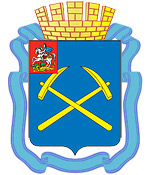
Podolsk city map, Russia
Podolsk city latest news and posts from our blog:.
4 June, 2016 / Church of Our Lady (Znamenskaya) in Dubrovitsy .
14 May, 2015 / Church of the Sign of Our Lady in Dubrovitsy .
29 October, 2013 / Unique Baroque Church in the Dubrovitsy Estate .
History of Podolsk
Podol was first mentioned in written sources as a village in 1606. It became a town by the Empress Catherine’s the Great order in 1781. The population of the town was 856 people. In the 18th century, the first stone buildings appeared in the town.
The main occupation of the inhabitants was mining of rubble and white stone, from which, for example, the famous Znamenskaya Church in Dubrovitsy was built. In 1781, Podolsk received a coat of arms with two golden pickaxes symbolizing the main occupation of the local residents.
In September 1812, the town was occupied by the French troops during the French Invasion of Russia. The Trinity Church, located in the center of the present city, was erected in memory of this event.
More Historical Facts…
The development of Podolsk was promoted by construction of the State Warsaw (Brest-Lithuanian) Highway in 1844-1847. In 1866, Moscow-Kursk Railway came to Podolsk, it favored the development of the local industry. In 1875, a cement-producing plant was opened (in 1913, cement made about 95% of all the freight taken from Podolsk).
In 1900, the American company “Zinger” began the construction of their plant in Podolsk, the first in the Russian Empire. Production of sewing machines began in 1902. In November 1918, the plant was nationalized by the Soviet power and production stopped. The first Soviet sewing-machines were produced only in 1924.
During the years of the Civil War, there was a significant reduction in the town’s population. In 1920, the population of Podolsk was about 12,000 people. By 1939, due to intensive industrial development, the city’s population reached 72,000 people. In the 1950s, industrial development continued. In 1979, the population of Podolsk was 201,700 people. It became the first city of the Moscow region (Moscow is not part of it) with a population of more than 200 thousand people.
Streets of Podolsk
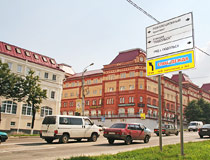
Lenin Avenue in Podolsk
Author: Alex N. Wild

Podolsk architecture

Podolsk - a city of contrasts
Podolsk - Features
The climate is temperate continental with relatively cold winter (early November - end of March) and warm humid summer (mid-May - early September). The average temperature in January is minus 9.4 degrees Celsius, in July - plus 18.4 degrees Celsius.
Podolsk is one of the largest industrial centers in the Moscow region. There are over 50 large and medium-sized industrial enterprises on the territory of the city. Besides, Podolsk is an important scientific center. There are several research institutions engaged mainly in nuclear machine-building and nuclear research.
Moscow - Kharkiv - Sevastopol railway passes through Podolsk. The federal highway M2 “Crimea” runs about 1 km east of Podolsk.
Attractions of Podolsk
There are a lot of monuments and memorial boards in Podolsk. The most interesting are the architectural and sculpture ensemble built in memory of World War II (Slavy Square) and the monument-obelisk to Miloradovich grenadiers who died in the Podolsk land in 1812 (Sobornaya Square, in front of the Trinity Cathedral).
The former Ivanovskoye estate and Dubrovitsy manor ensemble are also one of the main attractions of Podolsk.
- Podolsk Museum of Local Lore: the main building (Sovetskaya Square, 7), the branch of the museum in Ivanovskoye Estate (Parkovaya Street, 1);
- The Historical and Memorial Museum-Reserve “Podolye” (Lenina Avenue, 47);
- The Federal Museum of Professional Education (Parkovaya Street, 1);
- Podolsk Showroom (Lenina Avenue, 113/62).
- Podolsk Drama Theater PDK Drama (Pochtovaya Street, 8);
- “Vecherniy Zvon” (“Evening Bells”) Theater (Sverdlova Street, 38).
There are several Orthodox churches in the city. The Trinity (Troitsky) Cathedral (1819-1823) is the most famous. It was built in honor of the victory of the Russian Empire in the Russian-French War of 1812. During the Soviet regime, it was the only cathedral in the Moscow region open for visiting.
The Resurrection Church in Krasnaya Street is one of the oldest churches in Podolsk (first mentioned in 1627-1628).
Podolsk city of Russia photos
Pictures of podolsk.

The bridge across the river in Podolsk
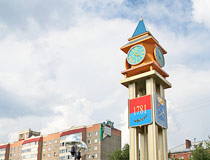
The clock tower in the center of Podolsk

Trinity Cathedral in Podolsk
Dubrovitsy manor ensemble located near Podolsk

Dubrovitsy is a very beautiful place

The main building of Dubrovitsy mansion

Znamenskaya Church in Dubrovitsy
- Currently 2.94/5
Rating: 2.9 /5 (181 votes cast)
- Yekaterinburg
- Novosibirsk
- Vladivostok

- Tours to Russia
- Practicalities
- Russia in Lists
Rusmania • Deep into Russia
- Moscow Region

Podolsk's most famous sight - the Our Lady of the Sign Church - is actually located just outside the city in Dubrovitsy and any visit to Podolsk should include a trip here. The city itself also has several sights worth seeing and both destinations can be visited as a day trip from Moscow .
Top recommendations in Podolsk

Go to Dubrovitsy to see the stunning and intricate Our Lady of the Sign Church.

Podolye Historical and Architectural Museum-Reserve
Visit the Podolye Historical and Architectural Museum-Reserve and see the house where Lenin's relatives once lived as well as examples of early 19th century architecture.
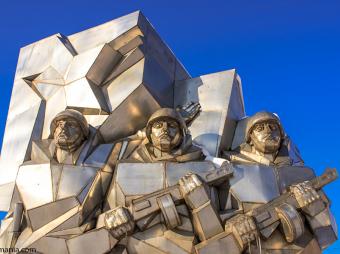
Podolsk Cadets Monument
Have a walk around Podolsk to look at the impressive Soviet-style Podolsk Cadets Monument and visit the Regional Museum located in the former Ivanoskoe Estate.
Plan your next trip to Russia
Ready-to-book tours.
Your holiday in Russia starts here. Choose and book your tour to Russia.
REQUEST A CUSTOMISED TRIP
Looking for something unique? Create the trip of your dreams with the help of our experts.

IMAGES
VIDEO
COMMENTS
In this episode, Lieutenant Tom Paris (Robert Duncan McNeill) becomes the first known person to travel faster than Warp 10; however, the achievement causes him to mutate into a salamander-like creature. The episode is widely regarded by fans and critics as one of the worst episodes of Voyager and of the entire Star Trek franchise.
Threshold: Directed by Alexander Singer. With Kate Mulgrew, Robert Beltran, Roxann Dawson, Jennifer Lien. Tom's attempt to cross the time warp threshold and make a name for himself results in rapid physical mutation.
Warp factor 10. Although considered a theoretical impossibility at the time, Tom Paris of the USS Voyager reached the warp 10 threshold in 2372, using shuttlecraft Cochrane, which was equipped with a transwarp drive and an extraordinarily rare form of dilithium discovered earlier that year.
After the ship discovers refined dilithium on a new planet, Tom Paris thinks he can use it to hit warp 10 and bring Voyager home to Earth in an instant. The episode makes an obvious nod to Chuck Yeager breaking the sound barrier. Tom's increasingly fixated efforts to cross the barrier reflect a disregard for the potential safety problems.
Warp 10 corresponds with infinite velocity, and a ship traveling at warp 10 would be in every point of space at once. After warp 10, you go into Transwarp. Traveling at warp 10 is possible, and was done by Tom Paris in a shuttle with a rare form of dilithium. The "problem" is that travel at warp 10 leads hyper-evolution, and backwards time travel.
By Witney Seibold / Feb. 2, 2024 3:31 pm EST. In the "Star Trek: Voyager" episode "Threshold" (January 9, 1996), the U.S.S. Voyager discovers a rare, extra-powerful version of dilithium, the ...
Voyager was 70,000 light years away, warp 10 TOS was 10 cubed, or 1000 times the speed of light. 70,000 light years divided by 1000 times speed of light equals 70 years. Less than a parsec per day. But they would get home - eventually. I understand speed was limited for literary reasons, to keep space from becoming too small.
Breaking the warp 10 barriere from the Star Trek: Voyager episode "Threshold". Cool shuttle jump to warp!Follow my Instagram page star_trek_collector https:/...
Conversely warping normal space damages subspace. Since warp 10 is the ultimate threshold then warp 10 should have produced irreparable damage to subspace so extreme that it stranded Voyager and Paris inside a part of space where the subspace had been damaged by the warp 10 flight.
I mean for all these astonishing situations (crossing warp 10, unifying with Universe, dying, resurrection, turning info something completely different) informed character growth.
Voyager: Threshold Once upon a time, the crew of Voyager decided to test the limits of warp drive and exceed warp 10, which everyone thought was impossible. They selected Tom Paris for the job and he got in the shuttle, drove away, crossed the warp threshold, and returned as a hero. Then, he started getting really sick.
The discovery of a new form of dilithium in the Delta Quadrant led Tom Paris of the U.S.S. Voyager to attempt to cut short the 70-year journey home the crew faced, by trying to cross the warp 10 threshold. He succeeded, but the transwarp effect caused a bizarre "evolution" of human cells, making such travel untenable. and
Star Trek: Voyager S2E15 "Threshold". Paris's genes devolve as quickly as the show's scientific accuracy. Here lies Thomas Eugene Paris. Beloved mutant. Tom Paris manages to use the holodeck to create an experimental way to travel at Transwarp, a way of travelling infinitely fast that would allow the ship to get home instantly.
The warp 10 barrier is a theoretical barrier for a starship with warp drive. Warp 10 is regarded as infinite velocity, so theoretically any vessel travelling at warp 10 would exist at all points in the universe at once, the scale is asymptotic, so Warp 9.99999 is many times faster than just Warp 9.9 In 2267, the USS Enterprise exceeded warp 10 (old scale) during its encounter with the Nomad ...
A specially-outfitted warp-capable shuttlecraft piloted by Tom Paris successfully reaches Warp 10, breaking the transwarp barrier. But the side effects of breaking the barrier may cost the crew of Voyager their best helmsman. In this episode of the podcast, Wes and Clay discuss "Threshold" and violating canon. Plus!
Warlord: Directed by David Livingston. With Kate Mulgrew, Robert Beltran, Roxann Dawson, Jennifer Lien. A dying warlord, determined to retake his home planet, takes over Kes's body.
Warp 10 Threshold. I'm currently re-watching Voyager for the first time in ages. I just watched the episode Threshold and have questions: It seems that warp 10, and thus the ability to be literally everywhere was successfully accomplished. There were some lizardy side-effects, but there was no dispute that the shuttle could travel at warp 10.
But the real reason is Warp 10, instant transportation breaks star trek. Star Trek is about the journey, not the destination. If the show suddenly got instant transportation to anywhere in the universe, not only would the Voyager end, but the franchise itself would be fundamentally changed.
After breaking past Warp 10 in trials to find a way to get home quicker, Paris begins slowly but inevitably transforming—at first seemingly mutating, but instead according to Voyager's ...
After months of nonsensical transmissions from humanity's most distant emissary, NASA's iconic Voyager 1 spacecraft is finally communicating intelligibly with Earth again. Voyager 1 launched ...
Earth's most distant spacecraft, Voyager 1, has started communicating properly again with Nasa after engineers worked for months to remotely fix the 46-year-old probe.. Nasa's Jet Propulsion ...
Voyager 1 stopped sending readable science and engineering data back to Earth on Nov. 14, 2023, even though mission controllers could tell the spacecraft was still receiving their commands and ...
2021: QR Code Implementation Pilot. The Department of Urban Planning Policy of the City of Moscow, together with the Office of the Mayor and the Government of Moscow and the Department of Information Technology of the City of Moscow, began piloting a service that will allow citizens to receive information about the progress of construction of the capital construction facility and its 3D ...
Moscow City Duma District 38 is one of 45 constituencies in Moscow City Duma.Currently the district covers eastern half of New Moscow, as well as parts of Prospekt Vernadskogo and Troparyovo-Nikulino.. The district has been represented since 2019 by United Russia member Aleksandr Kozlov, a housing and communal services expert, who succeeded retiring Independent one-term incumbent, SU-155 owner ...
Podolsk is a city in Russia standing on the banks of the Pakhra River, about 37 km from the center of Moscow, 15 km from the Moscow Ring Road. It is one of the largest satellite cities of Moscow (the second after Balashikha), a large industrial and cultural center of Moskovskaya oblast. The population of Podolsk is about 309,600 (2022), the ...
Basic facts. Name in Russian. Подольск. Status. City-municipality and administrative centre of the Podolsk District of the Moscow Region. Location. On the River Pakhra. Distance. 40km south of Moscow.